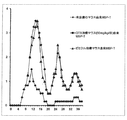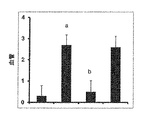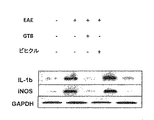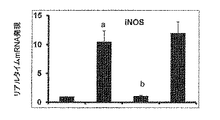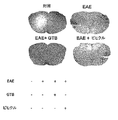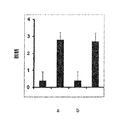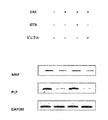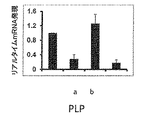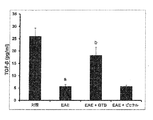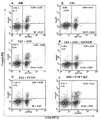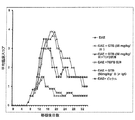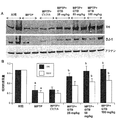JP2020037558A - Use of benzoate containing composition in urea cycle disorders and neurodegenerative disorders - Google Patents
Use of benzoate containing composition in urea cycle disorders and neurodegenerative disorders Download PDFInfo
- Publication number
- JP2020037558A JP2020037558A JP2019191224A JP2019191224A JP2020037558A JP 2020037558 A JP2020037558 A JP 2020037558A JP 2019191224 A JP2019191224 A JP 2019191224A JP 2019191224 A JP2019191224 A JP 2019191224A JP 2020037558 A JP2020037558 A JP 2020037558A
- Authority
- JP
- Japan
- Prior art keywords
- mice
- gtb
- glyceryl
- eae
- disease
- Prior art date
- Legal status (The legal status is an assumption and is not a legal conclusion. Google has not performed a legal analysis and makes no representation as to the accuracy of the status listed.)
- Pending
Links
Images
Classifications
-
- A—HUMAN NECESSITIES
- A61—MEDICAL OR VETERINARY SCIENCE; HYGIENE
- A61K—PREPARATIONS FOR MEDICAL, DENTAL OR TOILETRY PURPOSES
- A61K31/00—Medicinal preparations containing organic active ingredients
- A61K31/21—Esters, e.g. nitroglycerine, selenocyanates
- A61K31/215—Esters, e.g. nitroglycerine, selenocyanates of carboxylic acids
- A61K31/235—Esters, e.g. nitroglycerine, selenocyanates of carboxylic acids having an aromatic ring attached to a carboxyl group
-
- A—HUMAN NECESSITIES
- A23—FOODS OR FOODSTUFFS; TREATMENT THEREOF, NOT COVERED BY OTHER CLASSES
- A23L—FOODS, FOODSTUFFS, OR NON-ALCOHOLIC BEVERAGES, NOT COVERED BY SUBCLASSES A21D OR A23B-A23J; THEIR PREPARATION OR TREATMENT, e.g. COOKING, MODIFICATION OF NUTRITIVE QUALITIES, PHYSICAL TREATMENT; PRESERVATION OF FOODS OR FOODSTUFFS, IN GENERAL
- A23L33/00—Modifying nutritive qualities of foods; Dietetic products; Preparation or treatment thereof
- A23L33/10—Modifying nutritive qualities of foods; Dietetic products; Preparation or treatment thereof using additives
-
- A—HUMAN NECESSITIES
- A61—MEDICAL OR VETERINARY SCIENCE; HYGIENE
- A61K—PREPARATIONS FOR MEDICAL, DENTAL OR TOILETRY PURPOSES
- A61K9/00—Medicinal preparations characterised by special physical form
- A61K9/0012—Galenical forms characterised by the site of application
- A61K9/0053—Mouth and digestive tract, i.e. intraoral and peroral administration
-
- A—HUMAN NECESSITIES
- A61—MEDICAL OR VETERINARY SCIENCE; HYGIENE
- A61P—SPECIFIC THERAPEUTIC ACTIVITY OF CHEMICAL COMPOUNDS OR MEDICINAL PREPARATIONS
- A61P13/00—Drugs for disorders of the urinary system
-
- A—HUMAN NECESSITIES
- A61—MEDICAL OR VETERINARY SCIENCE; HYGIENE
- A61P—SPECIFIC THERAPEUTIC ACTIVITY OF CHEMICAL COMPOUNDS OR MEDICINAL PREPARATIONS
- A61P25/00—Drugs for disorders of the nervous system
-
- A—HUMAN NECESSITIES
- A61—MEDICAL OR VETERINARY SCIENCE; HYGIENE
- A61P—SPECIFIC THERAPEUTIC ACTIVITY OF CHEMICAL COMPOUNDS OR MEDICINAL PREPARATIONS
- A61P25/00—Drugs for disorders of the nervous system
- A61P25/14—Drugs for disorders of the nervous system for treating abnormal movements, e.g. chorea, dyskinesia
-
- A—HUMAN NECESSITIES
- A61—MEDICAL OR VETERINARY SCIENCE; HYGIENE
- A61P—SPECIFIC THERAPEUTIC ACTIVITY OF CHEMICAL COMPOUNDS OR MEDICINAL PREPARATIONS
- A61P25/00—Drugs for disorders of the nervous system
- A61P25/14—Drugs for disorders of the nervous system for treating abnormal movements, e.g. chorea, dyskinesia
- A61P25/16—Anti-Parkinson drugs
-
- A—HUMAN NECESSITIES
- A61—MEDICAL OR VETERINARY SCIENCE; HYGIENE
- A61P—SPECIFIC THERAPEUTIC ACTIVITY OF CHEMICAL COMPOUNDS OR MEDICINAL PREPARATIONS
- A61P25/00—Drugs for disorders of the nervous system
- A61P25/24—Antidepressants
-
- A—HUMAN NECESSITIES
- A61—MEDICAL OR VETERINARY SCIENCE; HYGIENE
- A61P—SPECIFIC THERAPEUTIC ACTIVITY OF CHEMICAL COMPOUNDS OR MEDICINAL PREPARATIONS
- A61P25/00—Drugs for disorders of the nervous system
- A61P25/28—Drugs for disorders of the nervous system for treating neurodegenerative disorders of the central nervous system, e.g. nootropic agents, cognition enhancers, drugs for treating Alzheimer's disease or other forms of dementia
-
- A—HUMAN NECESSITIES
- A61—MEDICAL OR VETERINARY SCIENCE; HYGIENE
- A61P—SPECIFIC THERAPEUTIC ACTIVITY OF CHEMICAL COMPOUNDS OR MEDICINAL PREPARATIONS
- A61P43/00—Drugs for specific purposes, not provided for in groups A61P1/00-A61P41/00
Abstract
Description
関連出願の相互参照
本出願は2014年1月17日に出願した米国仮特許出願第61/928,622号の利益を主張するものであり、その内容全体が本出願に組み入れられる。
CROSS REFERENCE TO RELATED APPLICATIONS This application claims the benefit of US Provisional Patent Application No. 61 / 928,622, filed January 17, 2014, the entire contents of which are incorporated herein.
1.本発明の技術分野
本発明は、一般に疾患及び障害の治療に有用な医薬組成物に関する。より具体的には、本発明は、グリセリルトリベンゾエート及び/又はグリセリルジベンゾエートを含む、尿素サイクル障害及び神経変性障害の治療のための医薬組成物に関する。
1. Technical Field of the Invention The present invention generally relates to a pharmaceutical composition useful for treating diseases and disorders. More specifically, the present invention relates to a pharmaceutical composition comprising glyceryl tribenzoate and / or glyceryl dibenzoate for the treatment of urea cycle disorders and neurodegenerative disorders.
2.関連技術の説明
ニッケイの茶色の樹皮であるシナモンは、デザート、キャンディ、チョコレート等に一般的に用いられる香辛料及び調味料である。それにはまた、薬として用いられてきた長い歴史がある。中世の医師は、関節炎、咳嗽、嗄声、咽頭炎等を含む種々の障害を治療するために、薬にシナモンを用いた。シナモンは、マンガン、食物繊維、鉄、及びカルシウムを含有することに加えて、3つの主要な化合物、シンナムアルデヒド、シンナミルアセテート及びシンナミルアルコールを含有する。摂取後、これらの3つの活性化合物は、酸化及び加水分解によって、それぞれケイ皮酸に変換される。次いで、ケイ皮酸は肝臓でβ酸化されてベンゾエートになる。このベンゾエートは、ナトリウム塩(安息香酸ナトリウム)又はベンゾイル-CoAとして存在する。
2. Description of Related Technology Nikkei's brown bark cinnamon is a spice and seasoning commonly used in desserts, candy, chocolate and the like. It also has a long history of being used as a medicine. Medieval physicians used cinnamon as a drug to treat a variety of disorders, including arthritis, cough, hoarseness, pharyngitis, and the like. Cinnamon contains three main compounds, cinnamaldehyde, cinnamyl acetate and cinnamyl alcohol, in addition to containing manganese, dietary fiber, iron, and calcium. After ingestion, these three active compounds are converted to cinnamic acid by oxidation and hydrolysis, respectively. Cinnamic acid is then beta-oxidized in the liver to benzoate. This benzoate exists as a sodium salt (sodium benzoate) or benzoyl-CoA.
安息香酸ナトリウムは、その抗微生物性のために、広く用いられている食物防腐剤である。それは、尿素サイクル障害のような高アンモニア血症と関連した、肝代謝異常の治療に用いられる食品医薬品局(FDA)認可の薬物であるUcephan(商標)の成分として、医学的な重要性も持つ。本発明者は、雌のSJL/Jマウスにおいて再発寛解型EAEの疾患過程を治療する際の、安息香酸ナトリウムの新規の使用を模索した(Brahmachari及びPahan、「Sodium benzoate, a food additive and a metabolite of cinnamon, modifies T cells at multiple steps and inhibits adoptive transfer of experimental allergic encephalomyelitis」、J. lmmunol.、2007、7月1日、179(1):275-83、を参照されたい。その全内容は、参照によって本出願に明白に組み入れられる)。 Sodium benzoate is a widely used food preservative because of its antimicrobial properties. It also has medical significance as a component of Ucephan (TM), a Food and Drug Administration (FDA) approved drug used to treat hepatic metabolic disorders associated with hyperammonemia such as urea cycle disorders . The present inventors sought a novel use of sodium benzoate in treating the disease process of relapsing-remitting EAE in female SJL / J mice (Brahmachari and Pahan, `` Sodium benzoate, a food additive and a metabolite of cinnamon, modifies T cells at multiple steps and inhibits adoptive transfer of experimental allergic encephalomyelitis ", J. lmmunol., 2007, July 1, 179 (1): 275-83. Which are expressly incorporated into this application by reference).
本発明者は、安息香酸ナトリウムが、マウスにおいて多発性硬化症(MS)の疾患過程を抑制することも発見した。本発明者は、安息香酸ナトリウムが、パーキンソン病(PD)及びアルツハイマー病(AD)のような神経変性障害と関連がある有益な神経保護タンパク質であるDJ-1と呼ばれるタンパク質を、上方制御するということも発見した。(Khasnavis及びPahan「Sodium Benzoate, a Metabolite of Cinnamon and a Food Additive, Upregulates Neuroprotective Parkinson Disease Protein DJ-1 in Astrocytes and Neurons」、Journal of Neuroimmune Pharmacology、2012年6月、7巻、2号、424〜435頁、を参照されたい。その全内容は、参照によって本出願に明白に組み入れられる)。 The inventors have also discovered that sodium benzoate suppresses the multiple sclerosis (MS) disease process in mice. The present inventors have stated that sodium benzoate up-regulates a protein called DJ-1, which is a beneficial neuroprotective protein associated with neurodegenerative disorders such as Parkinson's disease (PD) and Alzheimer's disease (AD). I also discovered that. (Khasnavis and Pahan `` Sodium Benzoate, a Metabolite of Cinnamon and a Food Additive, Upregulates Neuroprotective Parkinson Disease Protein DJ-1 in Astrocytes and Neurons '', Journal of Neuroimmune Pharmacology, June 2012, Vol. 7, No. 2, 424-435. Page, the entire contents of which are expressly incorporated into this application by reference).
さらに、脳由来神経栄養因子(BDNF)及びニューロトロフィン-3(NT-3)のような神経栄養因子のレベルが、AD及びPDのような異なる神経変性障害の患者の脳で減少することがわかっている。近年では、本発明者は、安息香酸ナトリウムが脳細胞でBDNF及びNT-3の産生を増加させることを詳細に報告し、それが神経変性障害に有益であり得ることを示した、(Janaら、「Up-regulation of neurotrophic factors by cinnamon and its metabolite sodium benzoate: therapeutic implications for neurodegenerative disorders」、J. Neuroimmune Pharmacol.、2013年6月、8(3):739-55、を参照されたい。その全内容は、参照によって本出願に明白に組み入れられる)。 Furthermore, levels of neurotrophic factors such as brain-derived neurotrophic factor (BDNF) and neurotrophin-3 (NT-3) may be reduced in the brain of patients with different neurodegenerative disorders such as AD and PD. know. In recent years, the present inventors have reported in detail that sodium benzoate increases the production of BDNF and NT-3 in brain cells and has shown that it may be beneficial for neurodegenerative disorders, (Jana et al. , "Up-regulation of neurotrophic factors by cinnamon and its metabolite sodium benzoate: therapeutic implications for neurodegenerative disorders", J. Neuroimmune Pharmacol., June 2013, 8 (3): 739-55. The contents are expressly incorporated into this application by reference).
しかし、安息香酸ナトリウムは速やかに代謝されて、体から排出される。したがって、血流から有毒なアンモニアを、継続的に確実に除去するために、少なくとも尿素サイクル障害に関連して、安息香酸ナトリウムは、通常1日につき3〜4回投与される。 However, sodium benzoate is rapidly metabolized and excreted from the body. Thus, sodium benzoate is usually administered three to four times per day, at least in connection with urea cycle disorders, to ensure the continued removal of toxic ammonia from the bloodstream.
本発明は、尿素サイクル障害及び神経変性障害の治療のための組成物及び方法に関する。一態様では、尿素サイクル障害の進行を阻害する方法が開示される。この方法は、グリセリルトリベンゾエート及び/又はグリセリルジベンゾエートを含む有効量の医薬組成物を、それを必要とする患者に投与することを含む。 The present invention relates to compositions and methods for treating urea cycle disorders and neurodegenerative disorders. In one aspect, a method of inhibiting progression of a urea cycle disorder is disclosed. The method comprises administering to a patient in need thereof an effective amount of a pharmaceutical composition comprising glyceryl tribenzoate and / or glyceryl dibenzoate.
別の態様では、神経変性障害の進行を阻害する方法が提供される。この方法は、グリセリルトリベンゾエート及び/又はグリセリルジベンゾエートを含む有効量の医薬組成物を、それを必要とする患者に投与することを含む。 In another aspect, a method is provided for inhibiting progression of a neurodegenerative disorder. The method comprises administering to a patient in need thereof an effective amount of a pharmaceutical composition comprising glyceryl tribenzoate and / or glyceryl dibenzoate.
本発明は、医薬の製造にも関する。一態様では、本発明は、尿素サイクル障害の治療のための医薬製造用のグリセリルトリベンゾエート及び/又はグリセリルジベンゾエート化合物の使用に関する。 The invention also relates to the manufacture of a medicament. In one aspect, the invention relates to the use of a glyceryl tribenzoate and / or glyceryl dibenzoate compound for the manufacture of a medicament for the treatment of a urea cycle disorder.
別の態様では、本発明は、神経変性障害の治療のための医薬製造用のグリセリルトリベンゾエート及び/又はグリセリルジベンゾエート化合物の使用に関する。 In another aspect, the invention relates to the use of a glyceryl tribenzoate and / or glyceryl dibenzoate compound for the manufacture of a medicament for the treatment of a neurodegenerative disorder.
あとに続く詳細な説明がよりよく理解されるように、前述では、むしろ概括的に本発明の特徴及び技術的利点を概説した。本発明のさらなる特徴及び利点は、本出願の特許請求の範囲の主題を構成する以下に記載される。開示された概念及び特定の実施形態が、本発明の同一の目的を実行するための他の実施形態を修正する又は設計するための基準として容易に利用され得ることは、当業者によって理解されるべきである。このような同等の実施形態が、添付の特許請求の範囲に記載したように、本発明の精神及び範囲から逸脱しないことも当業者によって理解されなければならない。 The foregoing has outlined rather broadly the features and technical advantages of the present invention in order that the detailed description that follows may be better understood. Further features and advantages of the invention are described below, which form the subject of the claims of the present application. It will be understood by those skilled in the art that the disclosed concepts and particular embodiments can be readily utilized as a basis for modifying or designing other embodiments to accomplish the same purpose of the invention. Should. It should also be understood by those skilled in the art that such equivalent embodiments do not depart from the spirit and scope of the present invention, as set forth in the appended claims.
種々の実施形態は、下に記載される。実施形態の種々の要素の関係及び機能は、以下の詳細な説明を参照することによって、よりよく理解され得る。しかし、実施形態は、本明細書で明白に開示されたものに限定されない。ある特定の場合において、本明細書で開示された実施形態の理解のために、必須ではない細部が省略されている場合があることを理解すべきである。 Various embodiments are described below. The relationships and functions of the various elements of the embodiments can be better understood with reference to the following detailed description. However, embodiments are not limited to those explicitly disclosed herein. It should be understood that in certain instances, non-essential details may have been omitted for an understanding of the embodiments disclosed herein.
安息香酸ナトリウムは、尿素サイクル障害、MS、PD、AD及び他の神経変性障害に関連して有益な効果を示すが、安息香酸ナトリウムが速やかに代謝されて体から排出されるという事実は、通常、1日につき約3〜4回この化合物を繰り返し患者に投与することによってのみ対処できるある特定の問題をもたらす。したがって、投与計画を減らすことができる安息香酸ナトリウムの徐放性の形態、及び患者の服薬遵守を改善することは、有益である。 Although sodium benzoate has beneficial effects in connection with urea cycle disorders, MS, PD, AD and other neurodegenerative disorders, the fact that sodium benzoate is rapidly metabolized and excreted from the body is usually This poses certain problems that can only be addressed by repeatedly administering this compound to a patient about three to four times per day. Thus, it would be beneficial to improve the sustained release form of sodium benzoate, which could reduce the dosage regimen, and patient compliance.
本発明は、医薬組成物の1日1回の投与だけを必要とする尿素サイクル障害及び神経変性障害のための新規治療を提供することによって、この問題に対処する。一部の態様では、尿素サイクル障害及び神経変性障害のための治療は、医薬組成物の1日2回の投与を含んでよい。ある特定の態様では、本明細書で開示された医薬組成物は、グリセリルトリベンゾエート(別名トリベンゾイン)を含む。他の態様では、本明細書で開示された医薬組成物は、グリセリルジベンゾエートを含む。一部の態様では、医薬組成物は、グリセリルトリベンゾエート及びグリセリルジベンゾエートの両方を含む。これらの分子が種々のリパーゼによって腸で切断されるので、グリセリルジベンゾエート及びグリセリルトリベンゾエートは体内で安息香酸ナトリウムをゆっくりと生ずる。したがって、グリセリルジベンゾエート及びグリセリルトリベンゾエートは安息香酸ナトリウムと比較して、非常に改善された治療有効性を示すと仮定される。 The present invention addresses this problem by providing new treatments for urea cycle disorders and neurodegenerative disorders that require only once daily administration of a pharmaceutical composition. In some embodiments, treatment for urea cycle disorders and neurodegenerative disorders may include twice daily administration of a pharmaceutical composition. In certain embodiments, the pharmaceutical compositions disclosed herein comprise glyceryl tribenzoate (also known as tribenzoin). In another aspect, the pharmaceutical compositions disclosed herein comprise glyceryl dibenzoate. In some aspects, the pharmaceutical composition comprises both glyceryl tribenzoate and glyceryl dibenzoate. As these molecules are cleaved in the gut by various lipases, glyceryl dibenzoate and glyceryl tribenzoate slowly produce sodium benzoate in the body. Therefore, it is hypothesized that glyceryl dibenzoate and glyceryl tribenzoate show greatly improved therapeutic efficacy compared to sodium benzoate.
本発明の一態様では、尿素サイクル障害の進行を阻害するために、治療が開示される。尿素サイクル障害は、血流からアンモニアを除去する役割を果たす尿素サイクルの酵素のうちの1つの欠損に起因する遺伝性障害である。尿素サイクルには6つの障害が知られている。各々は、欠損した酵素のイニシャルによって分類できる。したがって、6つの公知の尿素障害は、N-アセチルグルタミン酸シンターゼ(NAGS)、カルバモイルリン酸シンテターゼ1(CPS1)、オルニチントランスカルバモイラーゼ(OTC)、アルギニノコハク酸シンターゼ(ASS)、アルギニノコハク酸リアーゼ(ASL)及びアルギナーゼ1(ARG1)と呼ばれる場合がある。治療は、グリセリルトリベンゾエート及び/又はグリセリルジベンゾエートを含む有効量の医薬組成物を、それを必要とする患者に投与することを含む。本開示に従って、治療は1日1回実施されてよい。一部の態様では、治療は1日2回の実施を含んでよい。 In one aspect of the invention, a treatment is disclosed for inhibiting the progression of a urea cycle disorder. Urea cycle disorders are inherited disorders caused by a deficiency in one of the enzymes in the urea cycle that serves to remove ammonia from the bloodstream. Six obstacles to the urea cycle are known. Each can be classified by the initials of the missing enzyme. Thus, six known urea disorders are N-acetylglutamate synthase (NAGS), carbamoyl phosphate synthetase 1 (CPS1), ornithine transcarbamoylase (OTC), argininosuccinate synthase (ASS), and argininosuccinate lyase (ASL). And arginase 1 (ARG1). Treatment comprises administering to a patient in need thereof an effective amount of a pharmaceutical composition comprising glyceryl tribenzoate and / or glyceryl dibenzoate. In accordance with the present disclosure, treatment may be performed once a day. In some embodiments, treatment may include twice daily practice.
本発明の別の態様では、神経変性障害の進行を阻害するために、治療が開示される。治療は、グリセリルトリベンゾエート及び/又はグリセリルジベンゾエートを含む有効量の医薬組成物を、それを必要とする患者に投与することを含む。一部の態様では、神経変性障害は、PD、AD、MS、うつ病、ハンチントン病、認知症及びあらゆる記憶喪失障害からなる群から選択される。一部の態様では、神経変性障害は正常な対象と比較してBDNF又はNT-3のレベルの減少によって識別される場合がある。本開示に従って、治療は1日1回実施されてよい。一部の態様では、治療は1日2回の実施を含んでよい。 In another aspect of the invention, a treatment is disclosed for inhibiting the progression of a neurodegenerative disorder. Treatment comprises administering to a patient in need thereof an effective amount of a pharmaceutical composition comprising glyceryl tribenzoate and / or glyceryl dibenzoate. In some aspects, the neurodegenerative disorder is selected from the group consisting of PD, AD, MS, depression, Huntington's disease, dementia, and any memory loss disorder. In some embodiments, the neurodegenerative disorder may be identified by a decrease in the level of BDNF or NT-3 compared to a normal subject. In accordance with the present disclosure, treatment may be performed once a day. In some embodiments, treatment may include twice daily practice.
本発明によって考えられる治療方法では、グリセリルトリベンゾエート及び/又はグリセリルジベンゾエートが、単独で又は薬学的に許容される担体若しくは賦形剤と共に組成物で用いられてもよい。本明細書において、「薬学的に許容される担体」という用語は、無毒性、不活性の固体、半固体若しくは液体充填剤、希釈剤、封入材料、又は任意のタイプの製剤補助剤を意味する。薬学的に許容される担体の役割を果たすことができる材料のいくつかの例は、ラクトース、グルコース及びスクロースのような糖;コーンスターチ及びジャガイモデンプンのようなデンプン;カルボキシメチルセルロースナトリウム、エチルセルロース及びセルロースアセテートのようなセルロース及びその誘導体;粉末状トラガカンタ;モルト;ゼラチン;タルク;カカオバター及び坐薬ワックスのような賦形剤、ピーナッツ油、綿実油、サフラワー油、ゴマ油、オリーブ油、トウモロコシ油及びダイズ油のような油;プロピレングリコールのようなグリコール;エチルオレエート及びエチルラウレートのようなエステル;寒天;水酸化マグネシウム及び水酸化アルミニウムのような緩衝剤;アルギン酸;パイロジェンフリー水;等張生理食塩水;リンゲル液であり、エチルアルコール、及びリン酸緩衝液、並びにラウリル硫酸ナトリウム及びステアリン酸マグネシウムのような他の無毒性相溶性滑沢剤、並びに着色料、解除剤、コーティング剤、甘味料、香料及び芳香剤、防腐剤、及び酸化防止剤も、配合者の判断によって組成物中に存在することもできる。他の適した薬学的に許容される賦形剤は、「Remington's Pharmaceutical Sciences」、Mack Pub. Co.、New Jersey、1991、に記載され、その内容は、参照によって本明細書に明白に組み入れられる。 In the treatment methods contemplated by the present invention, glyceryl tribenzoate and / or glyceryl dibenzoate may be used in the composition, alone or with a pharmaceutically acceptable carrier or excipient. As used herein, the term "pharmaceutically acceptable carrier" means a non-toxic, inert solid, semi-solid or liquid filler, diluent, encapsulating material, or any type of formulation auxiliary. . Some examples of materials that can serve as pharmaceutically acceptable carriers include sugars such as lactose, glucose and sucrose; starches such as corn starch and potato starch; sodium carboxymethylcellulose, ethylcellulose and cellulose acetate. Such as cellulose and derivatives thereof; powdered tragacanth; malt; gelatin; talc; excipients such as cocoa butter and suppository waxes, such as peanut oil, cottonseed oil, safflower oil, sesame oil, olive oil, corn oil and soybean oil. Oil; glycols such as propylene glycol; esters such as ethyl oleate and ethyl laurate; agar; buffers such as magnesium hydroxide and aluminum hydroxide; alginic acid; pyrogen-free water; isotonic saline; Ringer's solution. , Ethyl alcohol, and phosphate buffers, and other non-toxic, compatible lubricants such as sodium lauryl sulfate and magnesium stearate, and colorants, release agents, coatings, sweeteners, flavors and fragrances; Preservatives and antioxidants may also be present in the compositions at the discretion of the formulator. Other suitable pharmaceutically acceptable excipients are described in "Remington's Pharmaceutical Sciences", Mack Pub. Co., New Jersey, 1991, the contents of which are expressly incorporated herein by reference. .
ある特定の実施形態では、グリセリルトリベンゾエート及び/又はグリセリルジベンゾエートは、ヒト及び他の動物に経口投与される場合がある。グリセリルトリベンゾエート及び/又はグリセリルジベンゾエートは、投与のために製剤化されてよく、製剤の方法は当技術分野では周知である(例えば、Remington: The Science and Practice of Pharmacy、Mack Publishing Company、Easton、Pa.、第19版 (1995)を参照されたい)。本開示に従う使用のための医薬組成物は、滅菌の形で、非発熱性溶液又は懸濁液、コーティングされたカプセル、凍結乾燥された粉末、又は当技術分野で公知の他の形である可能性がある。 In certain embodiments, glyceryl tribenzoate and / or glyceryl dibenzoate may be administered orally to humans and other animals. Glyceryl tribenzoate and / or glyceryl dibenzoate may be formulated for administration, and methods of formulation are well known in the art (e.g., Remington: The Science and Practice of Pharmacy, Mack Publishing Company, Easton, Pa., 19th edition (1995)). Pharmaceutical compositions for use in accordance with the present disclosure may be in sterile form, non-pyrogenic solutions or suspensions, coated capsules, lyophilized powders, or other forms known in the art. There is.
経口投与のための固体剤形は、カプセル剤、錠剤、丸剤、散剤及び顆粒剤を含む。このような固体剤形では、活性化合物は、少なくとも1種の不活性な、薬学的に許容される賦形剤又は担体、例えばクエン酸ナトリウム又はリン酸二カルシウム、並びに/又はa)充填剤又は増量剤、例えばデンプン、ラクトース、スクロース、グルコース、マンニトール及びケイ酸、b)結合剤、例えばカルボキシメチルセルロース、アルギン酸塩、ゼラチン、ポリビニルピロリジノン、スクロース及びアカシア、c)保湿剤、例えばグリセリン、d)崩壊剤、例えば寒天、炭酸カルシウム、ジャガイモ若しくはタピオカデンプン、アルギン酸、ある特定のケイ酸塩、及び炭酸ナトリウム、e)溶解遅延剤、例えばパラフィン、f)吸収促進剤、例えば第四級アンモニウム化合物、g)湿潤剤、例えばアセチルアルコール及びグリセロールモノステアレート、h)吸収剤、例えばカオリン及びベントナイト粘土、並びにi)滑沢剤、例えばタルク、ステアリン酸カルシウム、ステアリン酸マグネシウム、固体のポリエチレングリコール、ラウリル硫酸ナトリウム及びそれらの混合物、と混合される。カプセル剤、錠剤及び丸剤の場合、剤形は緩衝剤も含んでよい。 Solid dosage forms for oral administration include capsules, tablets, pills, powders, and granules. In such solid dosage forms, the active compound may comprise at least one inert, pharmaceutically acceptable excipient or carrier, such as sodium citrate or dicalcium phosphate, and / or a) a filler or Bulking agents such as starch, lactose, sucrose, glucose, mannitol and silicic acid, b) binders such as carboxymethylcellulose, alginate, gelatin, polyvinylpyrrolidinone, sucrose and acacia, c) humectants such as glycerin, d) disintegrants E.g., agar, calcium carbonate, potato or tapioca starch, alginic acid, certain silicates, and sodium carbonate, e) dissolution retardants such as paraffin, f) absorption enhancers such as quaternary ammonium compounds, g) wetting Agents such as acetyl alcohol and glycerol monostearate, h) Such as kaolin and bentonite clay, and i) lubricants such as talc, calcium stearate, magnesium stearate, solid polyethylene glycols, sodium lauryl sulfate, and mixtures thereof, to be mixed. In the case of capsules, tablets and pills, the dosage form may also comprise a buffer.
類似したタイプの固体組成物は、ラクトース又は乳糖並びに高分子量ポリエチレングリコールなどの賦形剤を用いた軟及び硬ゼラチンカプセルの充填剤として用いられてもよい。 A solid composition of a similar type may be used as a filler in soft and hard gelatin capsules using excipients such as lactose or milk sugar and high molecular weight polyethylene glycols.
錠剤、糖衣錠、カプセル剤、丸剤、及び顆粒剤の固体剤形は、腸溶性コーティング及び医薬製剤技術分野で周知の他のコーティングのような、コーティング及びシェルで調製することができる。それらは場合によって不透明剤を含有してよく、活性成分(複数可)だけを、又は優先して腸管のある特定の部分で、場合によって遅効性の方法で放出する組成物でもあり得る。使用することができる埋封組成物の例は、ポリマー物質及びワックスを含む。 Solid dosage forms of tablets, dragees, capsules, pills, and granules can be prepared with coatings and shells, such as enteric coatings and other coatings well known in the pharmaceutical formulating art. They may optionally contain opacifying agents and can also be of a composition that releases the active ingredient (s) only, or preferentially, in certain parts of the intestinal tract, optionally in a delayed manner. Examples of embedding compositions that can be used include polymeric substances and waxes.
活性化合物は、上記のように1種以上の賦形剤と共にマイクロカプセルに入れた形状にすることもできる。錠剤、糖衣錠、カプセル剤、丸剤、及び顆粒剤の固体剤形は、腸溶性コーティング、放出調節コーティング及び医薬製剤技術分野で周知の他のコーティングのような、コーティング及びシェルで調製することができる。このような固体剤形では、活性化合物は、少なくとも1種の、スクロース、ラクトース又はデンプンのような不活性な希釈剤と混合されてよい。このような剤形は、通常の慣行であるように、不活性な希釈剤以外の追加の物質、例えば、錠剤化における滑沢剤並びにステアリン酸マグネシウム及び微結晶性セルロースのような他の錠剤化における補助剤も含んでよい。カプセル剤、錠剤及び丸剤の場合、剤形は緩衝剤も含んでよい。それらは場合によって不透明剤を含有してよく、活性成分(複数可)だけを、又は優先して腸管のある特定の部分で、場合によって遅効性の方法で放出する組成物でもあり得る。使用することができる埋封組成物の例は、ポリマー物質及びワックスを含む。 The active compounds can also be in microencapsulated form with one or more excipients as noted above. Solid dosage forms of tablets, dragees, capsules, pills, and granules can be prepared with coatings and shells, such as enteric coatings, modified release coatings and other coatings well known in the pharmaceutical formulating art. . In such solid dosage forms, the active compound may be mixed with at least one inert diluent, such as sucrose, lactose or starch. Such dosage forms may comprise, as is normal practice, additional substances other than inert diluents, such as lubricants in tableting and other tableting agents such as magnesium stearate and microcrystalline cellulose. May also be included. In the case of capsules, tablets and pills, the dosage form may also comprise a buffer. They may optionally contain opacifying agents and can also be of a composition that releases the active ingredient (s) only, or preferentially, in certain parts of the intestinal tract, optionally in a delayed manner. Examples of embedding compositions that can be used include polymeric substances and waxes.
経口投与用の液体剤形は、薬学的に許容される乳剤、マイクロ乳剤、溶剤、懸濁剤、シロップ剤及びエリキシル剤を含む。活性化合物に加えて、液体剤形は、当技術分野で一般的に用いられる不活性な希釈剤を含有してよく、例えば水又は他の溶媒、エチルアルコール、イソプロピルアルコール、エチルカーボネート、EtOAc、ベンジルアルコール、安息香酸ベンジル、プロピレングリコール、1,3-ブチレングリコール、ジメチルホルムアミド、油(特に、綿実、落花生類、トウモロコシ、胚芽、オリーブ、ヒマシ及びゴマの油)、グリセリン、テトラヒドロフルフリルアルコール、ポリエチレングリコール及びソルビタンの脂肪酸エステルのような可溶化剤及び乳化剤、並びにそれらの混合物である。不活性な希釈剤の他に、経口の組成物は、湿潤剤、乳化剤及び懸濁剤、甘味料、香料及び芳香剤のようなアジュバントを含むこともできる。 Liquid dosage forms for oral administration include pharmaceutically acceptable emulsions, microemulsions, solvents, suspensions, syrups and elixirs. In addition to the active compound, liquid dosage forms may contain inert diluents commonly used in the art, such as water or other solvents, ethyl alcohol, isopropyl alcohol, ethyl carbonate, EtOAc, benzyl. Alcohol, benzyl benzoate, propylene glycol, 1,3-butylene glycol, dimethylformamide, oil (especially cottonseed, peanut, corn, germ, olive, castor and sesame oil), glycerin, tetrahydrofurfuryl alcohol, polyethylene Solubilizers and emulsifiers, such as fatty acid esters of glycols and sorbitan, and mixtures thereof. In addition to inert diluents, oral compositions can also include adjuvants such as wetting agents, emulsifying and suspending agents, sweetening, flavoring and flavoring agents.
本発明の有効量の組成物は、一般に、尿素サイクル障害及び神経変性障害のような障害の進行を阻害する(例えば、遅らせる、又は停止させる)のに十分な任意の量を含む。担体材料と合わせて単一の剤形を製造することができる活性成分(グリセリルトリベンゾエート及び/又はグリセリルジベンゾエート)の量は、治療されるホスト及び投与の特定の様式によって異なる。しかし、任意の特定の患者のための具体的な用量レベルは、用いられる特定の化合物の活性、年齢、体重、一般健康状態、性別、食事、投与時間、投与経路、排出率、薬物の組合せ、及び治療法を受けている特定の障害又は疾患の重症度を含む種々の要因によることは、理解される。所与の状態のための治療有効量は、ルーチンの実験で容易に決定することができ、普通の臨床医の技術及び判断の範囲内である。 An effective amount of a composition of the invention generally includes any amount sufficient to inhibit (eg, slow or stop) the progress of disorders such as urea cycle disorders and neurodegenerative disorders. The amount of active ingredient (glyceryl tribenzoate and / or glyceryl dibenzoate) that can be combined with the carrier materials to produce a single dosage form will vary depending upon the host treated and the particular mode of administration. However, specific dosage levels for any particular patient will depend on the activity, age, weight, general health, gender, diet, time of administration, route of administration, elimination rate, drug combination, of the particular compound used. It is understood that this depends on a variety of factors, including the severity of the particular disorder or disease being treated. A therapeutically effective amount for a given condition can be readily determined by routine experimentation, and is within the skill and judgment of the ordinary clinician.
本発明の治療方法によると、所望の結果を達成するような量、及び必要ならばそのような期間、グリセリルトリベンゾエート及び/又はグリセリルジベンゾエートの有効量をヒト又は下等な哺乳動物のような患者に投与することによって、該患者における障害の進行は遅くなる又は停止する。疾患又は障害の進行を遅らせる又は停止するために有効な化合物の量は、どんな医学的治療にでも適用できる妥当なベネフィット/リスク比で、疾患又は障害を治療するために十分な化合物の量と呼んでよい。 According to the method of treatment of the present invention, an effective amount of glyceryl tribenzoate and / or glyceryl dibenzoate is used to achieve the desired result and, if necessary, for such a period, such as a human or lower mammal. Administration to a patient slows or stops the progression of the disorder in the patient. An amount of a compound that is effective to slow or stop the progress of a disease or disorder is referred to as an amount of the compound that is sufficient to treat the disease or disorder, at a reasonable benefit / risk ratio applicable to any medical treatment. Is fine.
しかし、本発明の化合物及び組成物の一日の合計使用量は、理にかなった医学判断の範囲内で主治医によって決定されることは、理解される。任意の特定の患者のための具体的な治療的に有効な用量レベルは、治療される疾患又は障害、及び障害の重症度、用いられる特定の化合物の活性、用いられる特定の組成物;患者の年齢、体重、一般健康状態、性別、及び食事、用いられる特定の化合物の投与時間、投与経路、及び排出率、治療期間、用いられる特定の化合物と組み合わせて又は同時に使用する薬物、並びに医薬技術分野で周知の要因などを含む種々の要因による。 It will be understood, however, that the total daily usage of the compounds and compositions of the present invention will be decided by the attending physician within the scope of sound medical judgment. The specific therapeutically effective dose level for any particular patient will depend on the disease or disorder to be treated and the severity of the disorder, the activity of the particular compound used, the particular composition used; Age, body weight, general health, gender, and diet, administration time, route of administration, and elimination rate of the specific compound used, treatment period, drugs used in combination with or concurrent with the specific compound used, and pharmaceutical technology , Due to various factors including those well known in the above.
ヒトのような温血動物に投与される、グリセリルトリベンゾエート及び/又はグリセリルジベンゾエートのような本発明の化合物の「有効量」又は用量は、治療される障害によって異なる場合がある。尿素サイクル障害に関連して、本発明のある特定の態様では、有効量は、50kgの人で1日あたり約3gから約10gまで、又はその任意の量若しくは部分範囲であってよい。例えば、有効量は、約4g、約5g、約6g、約7g、約8g又は約9gであってよい。一部の態様では、用量は、50kgの人で1日あたり約3gから約6gまでであってよい。他の態様では、有効量は、1人1日あたり約100mg/kgから約200mg/kgまでであってよい。神経変性障害に関連して、本発明のある特定の態様では、有効量は、50kgの人で1日あたり約1gから約5gまで、又はその任意の量若しくは部分範囲であってよい。例えば、有効量は、約2g、約3g、又は約4gであってよい。一部の態様では、用量は、50kgの人で1日あたり約1gから約3gまでであってよい。特定の一態様では、用量は、50kgの人で1日あたり約1.25gであってよい。他の態様では、有効量は、1人1日あたり約25mg/kgから約50mg/kgまでであってよい。 The "effective amount" or dose of a compound of the invention, such as glyceryl tribenzoate and / or glyceryl dibenzoate, to be administered to a warm-blooded animal, such as a human, may vary depending on the disorder being treated. In connection with urea cycle disorders, in certain embodiments of the invention, the effective amount may be from about 3 g to about 10 g per day for a 50 kg person, or any amount or subrange thereof. For example, an effective amount can be about 4 g, about 5 g, about 6 g, about 7 g, about 8 g, or about 9 g. In some embodiments, the dose may be from about 3 g to about 6 g per day for a 50 kg person. In other embodiments, the effective amount may be from about 100 mg / kg to about 200 mg / kg per person per day. In the context of a neurodegenerative disorder, in certain embodiments of the invention, the effective amount may be from about 1 g to about 5 g per day for a 50 kg person, or any amount or subrange thereof. For example, an effective amount can be about 2 g, about 3 g, or about 4 g. In some embodiments, the dose may be from about 1 g to about 3 g per day for a 50 kg person. In one particular embodiment, the dose may be about 1.25 g per day for a 50 kg person. In other embodiments, the effective amount may be from about 25 mg / kg to about 50 mg / kg per person per day.
以下の実験は、MS、PD及び尿素サイクル障害の治療においてグリセリルトリベンゾエート(トリベンゾイン)及び/又はグリセリルジベンゾエートの有効性を試験するために行われた(又は行われる)。以下に述べる実施例は、グリセリルトリベンゾエートを用いた実験を示す。類似した実験は、グリセリルジベンゾエート、又はグリセリルトリベンゾエート及びグリセリルジベンゾエートの組合せを用いて行われる。 The following experiments were performed (or performed) to test the efficacy of glyceryl tribenzoate (tribenzoin) and / or glyceryl dibenzoate in treating MS, PD and urea cycle disorders. The examples described below show experiments using glyceryl tribenzoate. Similar experiments are performed with glyceryl dibenzoate or a combination of glyceryl tribenzoate and glyceryl dibenzoate.
養子移入実験的アレルギー性脳脊髄炎(EAE)。雌のSJL/Jマウス(4〜5週齢)は、Harlan Sprague-Dawley(Indianapolis、IN)から購入した。不完全フロイントアジュバント(IFA)中の、400μgのウシのミエリン塩基性タンパク(MBP)及び60μgの結核菌(M. tuberculosis)で、ドナーマウスは皮下免疫した。動物は免疫化後10〜12日に屠殺し、流入領域リンパ節を回収し、単一細胞懸濁液を10%ウシ胎児血清(FBS)、50μg/mL MBP、50μM 2-ME、2mM L-グルタミン、100U/mlペニシリン及び100μg/mlストレプトマイシンを付加したRPMI 1640中で培養した。4日目に、細胞を回収し、ハンクス液(HBSS)に再懸濁した。200μLの体積中に合計2×107の生細胞を、未処置マウスの尾静脈に注射した。百日咳毒素(150ng/マウス、Sigma-Aldrich)を、細胞移植後(dpt)0日に、腹腔内経路で1回注射した。臨床症状について、動物を毎日観察した。各群で、6匹のマウスを用いた。雌のマウス(4〜5週齢)を、いずれかの群に無作為に選択した。盲検によって検査員が、以下の通りに実験動物をスコア化した:0、臨床的疾患なし;0.5、立毛;1、尾部脱力;1.5、尾部麻痺;2、後肢脱力;3、後肢麻痺;3.5、前肢脱力;4、前肢麻痺;5、瀕死又は死。図1A及び2で、y軸は平均臨床スコアであり、x軸は移植後日数である。図1B〜1Cで、y軸は平均臨床スコアであり、x軸は免疫化後の日数である。
Adoptive transfer experimental allergic encephalomyelitis (EAE). Female SJL / J mice (4-5 weeks old) were purchased from Harlan Sprague-Dawley (Indianapolis, IN). Donor mice were immunized subcutaneously with 400 μg of bovine myelin basic protein (MBP) and 60 μg of M. tuberculosis in incomplete Freund's adjuvant (IFA). Animals were sacrificed 10-12 days after immunization, draining lymph nodes were collected, and single cell suspension was treated with 10% fetal bovine serum (FBS), 50 μg / mL MBP, 50 μM 2-ME, 2 mM L-. Cultures were performed in RPMI 1640 supplemented with glutamine, 100 U / ml penicillin and 100 μg / ml streptomycin. On
5B6 PLP-TCR Tgマウスの再発性EAE。PLP139-151特異的5B6 TCR Tgマウスは、Vijay Kuchroo教授(Harvard Medical School、Boston、MA)から入手した。雌のTgマウス(4〜5週齢)は、上述のように、IFA中、結核菌中の10又は25μg PLP139-151で免疫した。マウスには、免疫化後(dpi)0日に1回、百日咳毒素(150ng/マウス)も投与した。EAE群(図1B)では、雌のPLP-TCR遺伝子組換えマウスが25μg PLP139-151で免疫され、2匹のマウスは免疫化後(dpi)17日で人的介入なしで死亡し、4匹の瀕死のマウスが麻酔後断頭された。しかし、疾患スケールによれば、この群の全6匹のマウスは、スコア5とされた。 5B6 Recurrent EAE of PLP-TCR Tg mice. PLP 139-151 specific 5B6 TCR Tg mice were obtained from Professor Vijay Kuchroo (Harvard Medical School, Boston, MA). Female Tg mice (4-5 weeks old) were immunized with 10 or 25 μg PLP139-151 in M. tuberculosis in IFA as described above. Mice also received pertussis toxin (150 ng / mouse) once daily after immunization (dpi). In the EAE group (Fig. Moribund mice were decapitated after anesthesia. However, according to the disease scale, all six mice in this group scored 5.
慢性EAE。C57BL/6マウスは、上述のように、100μg MOG35-55で免疫した。マウスには、dpi0及び2に、2用量の百日咳毒素(150ng/マウス)も投与した。
Chronic EAE. C57BL / 6 mice were immunized with 100 μg MOG35-55 as described above. Mice also received two doses of pertussis toxin (150 ng / mouse) at
グリセリルトリベンゾエート(GTB)治療。GTBを0.5%メチルセルロース(MC)に混合し、強制飼養針を用いて、EAEマウスに1日1回100μL GTB混合MCを強制投与した。したがって、対照EAEマウスは、MCだけをビヒクルとして投与された。 Glyceryl tribenzoate (GTB) treatment. GTB was mixed with 0.5% methylcellulose (MC), and 100 μL of GTB-mixed MC was forcibly administered to EAE mice once a day using a gavage needle. Therefore, control EAE mice received only MC as vehicle.
組織学的顕微鏡。14dpi(最初の慢性期)に、次の群(対照、EAE、EAE+GTB及びEAE+ビヒクル)の各々から5匹のマウスに麻酔した。リン酸緩衝生理食塩水(PBS)(pH 7.4)で、次いでPBS中4%(w/v)パラホルムアルデヒド溶液で潅流後、小脳及び脊髄全体を、各マウスから摘出した。組織をさらに固定し、次いで半分に分割した。2分の1を組織学的染色に使用し、一方、残り半分をミエリン染色に使用した。組織学的分析のために、ルーチンの組織学を実行して、EAEマウスのCNS組織の血管周囲細胞浸潤及び形態学的詳細を得た。パラホルムアルデヒド固定組織をパラフィンに包埋し、連続切片(4μm)を切った。従来のH&E染色方法で、切片を染色した。40倍の対物レンズを用いた明視野設定で、デジタル画像を収集した。盲検によって3人の試験官が、異なる解剖学的区分(髄膜及び柔組織)の炎症についてスライドを評価した。次に記載するスケールを用いて、炎症をスコア化した:髄膜及び柔組織について:0、浸潤細胞なし;1、少数の浸潤細胞;2、多数の浸潤細胞;及び、3、広範囲にわたる浸潤。血管について:0、カフ付き血管(cuffed vessel)なし;1、切片につき1又は2個のカフ付き血管;2、切片につき3〜5個のカフ付き血管、及び3、切片につき5個以上のカフ付き血管。群につき5匹のマウスの各々から、各脊髄の少なくとも6つの連続切片をスコア化し、ANOVAによって統計学的に分析した。 Histological microscope. At 14 dpi (first chronic phase), 5 mice from each of the following groups (control, EAE, EAE + GTB and EAE + vehicle) were anesthetized. After perfusion with phosphate buffered saline (PBS) (pH 7.4) followed by a 4% (w / v) paraformaldehyde solution in PBS, the entire cerebellum and spinal cord were excised from each mouse. The tissue was further fixed and then split in half. One half was used for histological staining, while the other half was used for myelin staining. For histological analysis, routine histology was performed to obtain perivascular infiltration and morphological details of the CNS tissue of EAE mice. Paraformaldehyde fixed tissues were embedded in paraffin, and serial sections (4 μm) were cut. Sections were stained by the conventional H & E staining method. Digital images were collected in a bright field setting using a 40 × objective. By blind, three examiners evaluated slides for inflammation of different anatomical sections (meninges and parenchyma). Inflammation was scored using the scale described below: for meninges and parenchyma: 0, no invading cells; 1, few invading cells; 2, many invading cells; and 3, extensive invasion. For blood vessels: 0, no cuffed vessels; 1, 1 or 2 cuffed vessels per section; 2, 3-5 cuffed vessels per section, and 3, 5 or more cuffs per section With blood vessels. From each of 5 mice per group, at least 6 serial sections of each spinal cord were scored and analyzed statistically by ANOVA.
ミエリン用染色。以前に記載したように、ミエリン用のルクソールファストブルーで切片を染色した。盲検によって3人の試験官が、脱髄について次のスケールを用いてスライドを評価した:0、正常な白質;1、まばらな病巣;2、少ない範囲の脱髄;及び、3、広範にわたる脱髄。群につき5匹のマウスの各々から、各脊髄の少なくとも6つの連続切片をスコア化し、ANOVAによって統計学的に分析した。 Dyeing for myelin. Sections were stained with Luxor Fast Blue for myelin as previously described. Three examiners blindly assessed slides for demyelination using the following scale: 0, normal white matter; 1, sparse lesions; 2, small extent demyelination; and 3, extensive Demyelination. From each of 5 mice per group, at least 6 serial sections of each spinal cord were scored and analyzed statistically by ANOVA.
半定量的RT-PCR分析。RNeasyミニキット(Qiagen、Valencia、CA)を用いて脾臓T細胞及び脊髄から、Ultraspec-II RNA試薬(Biotecx laboratories, Inc、Houston、TX)を用いて脾臓及び小脳から、製造業者のプロトコルに従って全RNAを単離した。混入しているゲノムDNAを完全に除去するために、全RNAを、DNaseで消化した。半定量的RT-PCRは、Clonetech(Mountain View、CA)のRT-PCRキットを用いて行った。手短に述べると、20μL反応混合物中で、プライマーとしてオリゴ(dT)12〜18及びMMLV逆転写酵素(Clontech)を用いて、1μgの全RNAを逆転写した。得られたcDNAを適切に希釈し、希釈されたcDNAをTitanium Taq DNAポリメラーゼ及び以下のプライマーを用いて増幅した。増幅された産物は1.8%のアガロースゲル上で電気泳動にかけられ、エチジウムブロマイド染色によって視覚化された。 Semi-quantitative RT-PCR analysis. Total RNA from spleen T cells and spinal cord using RNeasy mini kit (Qiagen, Valencia, CA), from spleen and cerebellum using Ultraspec-II RNA reagent (Biotecx laboratories, Inc, Houston, TX) according to manufacturer's protocol. Was isolated. Total RNA was digested with DNase to completely remove contaminating genomic DNA. Semi-quantitative RT-PCR was performed using an RT-PCR kit from Clonetech (Mountain View, CA). Briefly, 1 μg of total RNA was reverse transcribed in a 20 μL reaction mixture using oligo (dT) 12-18 and MMLV reverse transcriptase (Clontech) as primers. The obtained cDNA was appropriately diluted, and the diluted cDNA was amplified using Titanium Taq DNA polymerase and the following primers. The amplified product was electrophoresed on a 1.8% agarose gel and visualized by ethidium bromide staining.
(配列番号:1)iNOS:センス:5'-CCCTTCCGAAGTTTCTGGCAGCAGC-3' (SEQ ID NO: 1) iNOS: Sense: 5'-CCCTTCCGAAGTTTCTGGCAGCAGC-3 '
(配列番号:2)アンチセンス:5'-GGCTGTCAGAGCCTCGTGGCTTTGG-3' (SEQ ID NO: 2) Antisense: 5'-GGCTGTCAGAGCCTCGTGGCTTTGG-3 '
(配列番号:3)IL-1β:センス:5'-CTCCATGAGCTTTGTACAAGG-3' (SEQ ID NO: 3) IL-1β: Sense: 5′-CTCCATGAGCTTTGTACAAGG-3 ′
(配列番号:4)アンチセンス:5'-TGCTGATGTACCAGTTGGGG-3' (SEQ ID NO: 4) Antisense: 5'-TGCTGATGTACCAGTTGGGG-3 '
(配列番号:5)MBP:センス:5'-TGGAGAGATTCACCGAGGAGA-3' (SEQ ID NO: 5) MBP: Sense: 5'-TGGAGAGATTCACCGAGGAGA-3 '
(配列番号:6)アンチセンス:5'-TGAAGCTCGTCGGACTCTGAG-3' (SEQ ID NO: 6) Antisense: 5'-TGAAGCTCGTCGGACTCTGAG-3 '
(配列番号:7)GAPDH:センス:5'-GGTGAAGGTCGGTGTGAACG-3' (SEQ ID NO: 7) GAPDH: Sense: 5'-GGTGAAGGTCGGTGTGAACG-3 '
(配列番号:8)アンチセンス:5'-TTGGCTCCACCCTTCAAGTG-3' (SEQ ID NO: 8) Antisense: 5'-TTGGCTCCACCCTTCAAGTG-3 '
GAPDHに対する各遺伝子の相対的発現量を、Fluor Chem 8800 Imaging System(Alpha Innotech、San Leandro、CA)でバンドをスキャンした後に測定した。 The relative expression level of each gene relative to GAPDH was measured after scanning the band with a Fluor Chem 8800 Imaging System (Alpha Innotech, San Leandro, CA).
リアルタイムPCR分析は、ABI-Prism7700配列検出システム(Applied Biosystems、Foster City、CA)を用いて行った。手短に述べると、反応は、96ウェルオプティカルリアクションプレートで、12.5μL TaqMan Universal Masterミックス、及び最適化された濃度のFAM標識プローブ、製造業者のプロトコルに従うフォワード及びリバースプライマーを含有する、25μLの体積に50ngのDNase消化RNAに相当するcDNAで行った。マウス遺伝子及びGAPDHのためのすべてのプライマー及びFAM標識プローブは、Applied Biosystemsから入手した。それぞれの遺伝子のmRNA発現は、GAPDH mRNAのレベルに標準化した。データをABI Sequence Detection System 1.6ソフトウェアによって処理し、ANOVAで分析した。 Real-time PCR analysis was performed using the ABI-Prism 7700 sequence detection system (Applied Biosystems, Foster City, CA). Briefly, reactions were performed in a 96-well optical reaction plate to a volume of 25 μL containing 12.5 μL TaqMan Universal Master mix and optimized concentration of FAM-labeled probe, forward and reverse primers according to the manufacturer's protocol. Performed with cDNA corresponding to 50 ng of DNase digested RNA. All primers and FAM-labeled probes for mouse genes and GAPDH were obtained from Applied Biosystems. MRNA expression of each gene was normalized to GAPDH mRNA levels. Data was processed by ABI Sequence Detection System 1.6 software and analyzed by ANOVA.
TGF-β ELISA。培養液上清中のTGF-βの産生は、eBioscience(San Diego、CA)のアッセイキットを用いたELISAによってモニターした。 TGF-β ELISA. Production of TGF-β in the culture supernatant was monitored by ELISA using an assay kit from eBioscience (San Diego, CA).
フローサイトメトリー。以前に記載したように、2色フローサイトメトリーを実行した。手短に述べると、フロー染色緩衝液中に懸濁された1×106のリンパ節細胞(LNC)又は脾細胞を、4℃で、適切に希釈されたCD4に対するFITC標識抗体と30分間インキュベートし、洗浄し、固定及び透過化処理溶液に再懸濁した。30分間暗所でインキュベーション後、細胞を洗浄し、透過化処理緩衝液中の試験Fcブロック(抗マウスCD16/32)で遮断し、その後、4℃、暗所で、適切に希釈されたFoxp3に対するPE標識抗体とインキュベートした。インキュベーション後、細胞懸濁液を遠心分離し、3回洗浄し、フロー染色緩衝液に再懸濁した。次いで細胞を、FACS(BD Biosciences、San Jose、CA)で分析した。細胞に、形態学的性質に基づいてゲートをかけた。アポトーシス及び壊死の細胞は、FACS分析には許容されなかった。 Flow cytometry. Two-color flow cytometry was performed as described previously. Briefly, 1 × 10 6 lymph node cells (LNC) or splenocytes suspended in flow staining buffer were incubated for 30 minutes at 4 ° C. with appropriately diluted FITC-labeled antibodies against CD4. , Washed and resuspended in fixation and permeabilization solution. After incubation in the dark for 30 minutes, the cells are washed and blocked with the test Fc block (anti-mouse CD16 / 32) in permeabilization buffer, then incubated at 4 ° C in the dark against appropriately diluted Foxp3. Incubated with PE labeled antibody. After incubation, the cell suspension was centrifuged, washed three times, and resuspended in flow staining buffer. The cells were then analyzed by FACS (BD Biosciences, San Jose, CA). Cells were gated based on morphological properties. Apoptotic and necrotic cells were not acceptable for FACS analysis.
GTBは雌のSJL/JマウスにおけるEAEの養子移入を阻害する。本発明者は、MBP初回抗原刺激を受けたT細胞の養子移入によって、雌のSJL/JマウスにRR-EAEを誘導した。これらのEAEマウスは、0.5以上の臨床スコアを示した場合では、移植後(dpt)8日から、GTBの異なる用量で治療された。マウスのさらなる群は、ビヒクルで治療された(図1A)。25mg/kg体重/日の用量でさえ、GTBは有意に臨床症状を阻害した(図1A)。一方、50mg/kg体重/日の用量では、EAEの急性及び慢性段階において臨床症状の劇的な阻害が観察された(図1A)。ビヒクル(0.1%メチルセルロース)はEAEの臨床症状を阻害することができないままであり(図1A)、効果の特異性が示唆された。しかし、100mg/kg体重/日の用量では、GTBは、臨床症状の抑制において、いずれも50mg/kg体重/日より強力ではなく(図1A)、高用量ではEAEマウスに有毒である場合があることが示唆された。
GTB inhibits adoptive transfer of EAE in female SJL / J mice. The present inventors induced RR-EAE in female SJL / J mice by adoptive transfer of MBP primed T cells. These EAE mice were treated with different doses of GTB from
GTBは、雌のPLP-TCR遺伝子組換えマウスで、EAEの臨床症状及び疾患重症度を阻害する。次に、本発明者は、雌のPLP-TCR遺伝子組換え(Tg)マウスで、GTB治療がEAEの進行も抑制することができるか否かを調べた。報告されたように、PLP139-151の低用量(10μg/マウス)による免疫化は、雌のPLP-TCR TgマウスでEAEの臨床症状を強く誘導した(図1B)。EAEマウスを、免疫化後(dpi)8日から、GTBの異なる用量で治療した。臨床症状に関するGTBの阻害効果は、治療の2、3日以内に、明らかに観察された(図1B)。より大きな阻害は治療以降の日に観察され、それは実験期間中維持された(図1B)。この場合も、EAEの最大の阻害は、GTBの50mg/kg体重/日の用量で観察された(図1B)。一方、ビヒクルはこのような阻害効果を持たなかった(図1B)。 GTB inhibits clinical symptoms and disease severity of EAE in female PLP-TCR transgenic mice. Next, the present inventors investigated whether GTB treatment could also suppress the progression of EAE in female PLP-TCR transgenic (Tg) mice. As reported, immunization with a low dose of PLP139-151 (10 μg / mouse) strongly induced clinical symptoms of EAE in female PLP-TCR Tg mice (FIG. 1B). EAE mice were treated with different doses of GTB starting 8 days after immunization (dpi). The inhibitory effect of GTB on clinical symptoms was clearly observed within a few days of treatment (FIG. 1B). Greater inhibition was observed on days after treatment, which was maintained throughout the experiment (FIG. 1B). Again, maximal inhibition of EAE was observed at a dose of 50 mg / kg body weight / day of GTB (FIG. 1B). On the other hand, the vehicle did not have such an inhibitory effect (FIG. 1B).
GTBは、雄のC57/BL6マウスで、慢性EAEを阻害する。雌のSJL/Jマウスを用いてRR-EAEを誘導するのに対して、EAEの慢性型は、MOG35-55での免疫化によって雄のC57/BL6マウスでモデル化される。したがって、本発明者は慢性EAEの疾患進行の抑制におけるGTBの有効性を調べた。雌のSJL/Jマウス及びPLP-TCR TgマウスにおけるRR-EAEに対するGTBの効果と同様に、GTB治療はこの慢性のモデルでも、強くEAEの臨床症状を阻害した(図1C)。その上に、ビヒクルは慢性EAEに効果がなく(図1C)、効果の特異性が示唆された。 GTB inhibits chronic EAE in male C57 / BL6 mice. Whereas RR-EAE is induced using female SJL / J mice, the chronic form of EAE is modeled in male C57 / BL6 mice by immunization with MOG35-55. Therefore, the present inventors examined the effectiveness of GTB in suppressing the disease progression of chronic EAE. Similar to the effect of GTB on RR-EAE in female SJL / J and PLP-TCR Tg mice, GTB treatment also strongly inhibited the clinical symptoms of EAE in this chronic model (FIG. 1C). Moreover, the vehicle had no effect on chronic EAE (FIG. 1C), suggesting a specific effect.
GTB治療は、ドナーマウスにおける脳炎誘発性T細胞の産生を阻害する。MBP免疫化ドナーマウスから単離されたT細胞は脳炎誘発性であり、これらのT細胞の養子移入は、レシピエントマウスにおいてEAEを誘導する。したがって、本発明者はGTBによるドナーマウスの治療が脳炎誘発性T細胞の産生を阻害することができるか否かを調べた。これを試験するために、ドナーマウスは、MBP免疫化の日から、経口的にGTB(50mg/kg体重/日)で治療された。GTB治療及び未治療のMBP免疫化ドナーマウスから単離されたT細胞は、次いでレシピエントマウスに養子移入された。結果は、GTB治療ドナーマウスからMBP初回抗原刺激を受けたT細胞を投与されたマウスは、未治療のドナーマウス又はビヒクル治療ドナーマウスからMBP初回抗原刺激を受けたT細胞を投与されたマウスと比較して、臨床症状及び疾患重症度がかなり減少したことを示した(図2)。これらの結果は、GTB治療は、ドナーマウスにおけるインビボでの脳炎誘発性T細胞の産生を阻害することを示唆する。 GTB treatment inhibits encephalitis-induced T cell production in donor mice. T cells isolated from MBP immunized donor mice are encephalogenic, and adoptive transfer of these T cells induces EAE in recipient mice. Therefore, the present inventors investigated whether treatment of donor mice with GTB could inhibit encephalitogenic T cell production. To test this, donor mice were treated orally with GTB (50 mg / kg body weight / day) from the day of MBP immunization. T cells isolated from GTB-treated and untreated MBP-immunized donor mice were then adoptively transferred to recipient mice. The results show that mice treated with MBP primed T cells from GTB-treated donor mice were compared with untreated donor mice or mice treated with MBP primed T cells from vehicle-treated donor mice. In comparison, clinical symptoms and disease severity were significantly reduced (FIG. 2). These results suggest that GTB treatment inhibits encephalitogenic T cell production in donor mice in vivo.
GTB治療によって、養子移入されたEAEマウスで血液脳関門(BBB)及び血液脊髄関門(BSB)の完全性が維持される。BBB及びBSBは、それぞれ脳及び脊髄を血液中の化学物質から保護するために主に働く膜構造であるが、多少の必須分子は入り込むことができる。活発なMS及びEAEの間、広範囲にわたる炎症のために、BBB及びBSBが、それぞれ脳及び脊髄の部分で分解し、それによって種々の血液分子及び毒素がCNSに入ることができるようになることが知られている。したがって、本発明者はGTB治療がBBB及びBSBの完全性を調整するか否かを調べた。本発明者は尾静脈を介して赤外線色素(Alexa-680)を注射し、注射2時間後に、生きたマウスをOdyssey赤外線スキャナで走査した。図3A(第1のレーン)から立証されるように、赤外線シグナルは、対照のHBSSを注射されたマウスの脳及び脊髄の領域上に見えなかった。一方、EAEマウスでは、赤外線シグナルは、脳及び脊髄の領域上に検出され(図3A、第2のカラム)、BBB及びBSBの分解の可能性が示唆される。しかし、GTB治療は、EAEマウスのCNSに赤外線色素が侵入することを強く阻害した(図3A、レーン3をレーン2と比較)。対照的に、脊髄及び脳の上に赤外線シグナルを合わせることによって立証されるように、ビヒクル治療はEAEマウスのCNSに赤外線色素が侵入することに影響せず(図3A、レーン4をレーン2と比較)、効果の特異性が示唆された。
GTB treatment maintains the integrity of the blood-brain barrier (BBB) and blood-spinal cord barrier (BSB) in adoptively transferred EAE mice. BBB and BSB are membrane structures that primarily serve to protect the brain and spinal cord from chemicals in the blood, respectively, but some essential molecules can enter. During active MS and EAE, due to extensive inflammation, BBB and BSB can degrade in parts of the brain and spinal cord, respectively, allowing various blood molecules and toxins to enter the CNS. Are known. Therefore, the present inventors investigated whether GTB treatment modulates BBB and BSB integrity. We injected the infrared dye (Alexa-680) via the tail vein and scanned live mice with an Odyssey
さらにこれらの結果を確認するために、マウスを屠殺し、脊髄及び脳の様々な部分(前頭皮質、中脳及び小脳)をOdyssey赤外線スキャナで赤外線シグナルを走査した。生きたマウスの結果と一致して、本発明者は対照のHBSS治療マウスの脊髄及び脳の様々な部分で多くの赤外線シグナルを認めなかったが(図3B〜D、レーン1)、かなり多くの赤外線色素がEAEマウスのCNS組織で見えた(図3B〜D、レーン2)。その上、EAEマウスのGTBによる治療は、脊髄及び脳の様々な部分に赤外線色素が侵入することを著しく軽減した(図3B〜D、レーン3をレーン2と比較)。まとめると、これらの結果は、GTB治療によって、EAEマウスにおけるBBB及びBSBの完全性が維持されることを示唆する。図3Cで、上段の行は前頭皮質に関するものであり、中段の行は中脳に関するものであり、下段の行は小脳に関するものである。図3Dで、第1のカラムは対照に関するものであり、第2のカラムはEAEに関するものであり、第3のカラムはEAE+GTBに関するものであり、第4のカラムはEAE+ビヒクルに関するものであり、y軸は赤外線シグナルの密度である。
To further confirm these results, mice were sacrificed and various parts of the spinal cord and brain (frontal cortex, midbrain and cerebellum) were scanned for infrared signals with an Odyssey infrared scanner. Consistent with live mouse results, we did not see many infrared signals in various parts of the spinal cord and brain of control HBSS-treated mice (FIGS.3B-D, lane 1), but significantly more. Infrared dye was visible in the CNS tissue of EAE mice (FIGS. 3B-D, lane 2). Moreover, treatment of EAE mice with GTB significantly reduced the invasion of infrared dyes into various parts of the spinal cord and brain (FIGS. 3B-D,
GTBは、EAEの脊髄で、単核細胞の浸潤、炎症及び脱髄を阻害する。自己反応性T細胞及び関連する単核細胞の浸潤は、EAE及びMSの特徴である。本発明者は、養子移入されたEAEマウスで、GTB治療が浸潤及び炎症を軽減するか否かを調べた。8dpt(急性期の開始)からGTBを投与されたマウスを、16dptに屠殺した。H&E染色は、EAEマウスの脊髄(図4A)への、炎症細胞の広範囲にわたる浸潤を示した。一方で、GTB治療は、EAEマウスの脊髄への炎症細胞の浸潤を著しく阻害した(図4A)。対照的に、ビヒクルは炎症細胞の浸潤を阻害することができなかった(図4A)。炎症細胞の相対レベルを定量すると、ビヒクルでなくGTBが、EAEマウスの脊髄で、浸潤(図4B)及びカフ付き血管の出現(図4C)を激減させることが示された。 GTB inhibits mononuclear cell infiltration, inflammation and demyelination in the spinal cord of EAE. Infiltration of autoreactive T cells and associated mononuclear cells is a characteristic of EAE and MS. The present inventors investigated whether GTB treatment reduced invasion and inflammation in adoptively transferred EAE mice. Mice receiving GTB from 8 dpt (start of acute phase) were sacrificed to 16 dpt. H & E staining showed extensive infiltration of inflammatory cells into the spinal cord of EAE mice (FIG. 4A). On the other hand, GTB treatment significantly inhibited inflammatory cell infiltration into the spinal cord of EAE mice (FIG. 4A). In contrast, the vehicle failed to inhibit inflammatory cell infiltration (FIG. 4A). Quantification of the relative levels of inflammatory cells indicated that GTB but not vehicle drastically reduced infiltration (FIG. 4B) and the appearance of cuffed blood vessels (FIG. 4C) in the spinal cord of EAE mice.
次に、本発明者は、GTBがEAEマウスの脊髄で炎症誘発性分子の発現を阻害することができるか否かを調べた。対照のマウスと比較して、未治療のEAEマウスの脊髄で、iNOS及びIL-1βのような炎症誘発性分子の著しい発現が観察された(図4D〜F)。しかし、GTB治療は、EAEマウスの脊髄におけるこれらの炎症誘発性分子の発現を激減させた(図4D〜F)。 Next, the present inventors investigated whether GTB could inhibit the expression of pro-inflammatory molecules in the spinal cord of EAE mice. Significant expression of pro-inflammatory molecules such as iNOS and IL-1β was observed in the spinal cord of untreated EAE mice compared to control mice (FIGS. 4D-F). However, GTB treatment drastically reduced the expression of these pro-inflammatory molecules in the spinal cord of EAE mice (FIGS. 4D-F).
脱髄はMSにおいて最も重要な病理学的特徴であり、それはEAE動物でもモデル化される。したがって、本発明者は、GTBがEAEマウスを脱髄から保護するか否かを調べた。本発明者は、ミエリン用のルクソールファストブルー(LFB)によって脊髄切片を染色し、白質における広範囲にわたる脱髄帯を観察した(図5A〜B)。しかし、GTB治療は、EAEマウスの脊髄におけるミエリンレベルを著しく回復させた(図5A〜B)。対照的に、ビヒクルは、EAEマウスの脊髄におけるミエリンレベルを回復できなかった(図5A〜B)。この知見を確認するために、本発明者は、3つのミエリン遺伝子、ミエリン塩基性タンパク質(MBP)及びプロテオリピドタンパク質(PLP)の発現をモニターし、対照のマウスと比較して未治療のEAEマウスの脊髄で、これらの遺伝子のmRNA発現の著しい減少を観察した(図5C〜E)。しかし、ビヒクルではなくGTBで治療したEAEマウスの脊髄で、ミエリン遺伝子mRNA発現の有意な回復が観察された(図5C〜E)。 Demyelination is the most important pathological feature in MS, which is also modeled in EAE animals. Therefore, the present inventors investigated whether GTB protects EAE mice from demyelination. We stained spinal cord sections with Luxol Fast Blue (LFB) for myelin and observed extensive demyelination bands in white matter (FIGS. 5A-B). However, GTB treatment significantly restored myelin levels in the spinal cord of EAE mice (FIGS. 5A-B). In contrast, vehicle failed to restore myelin levels in the spinal cord of EAE mice (FIGS. 5A-B). To confirm this finding, we monitored the expression of three myelin genes, myelin basic protein (MBP) and proteolipid protein (PLP), and compared untreated EAE mice to control mice. A marked decrease in mRNA expression of these genes was observed in the spinal cord of (Fig. 5C-E). However, significant recovery of myelin gene mRNA expression was observed in the spinal cord of EAE mice treated with GTB but not vehicle (FIGS. 5C-E).
GTB治療は、TGF-βを介して、EAEマウスにおいてTregsを保護する。TGF-βは、EAEからマウスを保護することが知られているので、本発明者は、ELISAによって、GTB治療及び未治療のEAEマウスの血清におけるTGF-βのレベルを調べた。8dptからGTB又はビヒクルを投与されたEAEマウスを16dptに屠殺し、血清中のTGF-βを分析した。本発明者は、対照のマウスと比較して、EAEマウスの血清でTGF-βの著しい減少を観察した(図6)。しかし、ビヒクルでなくGTBによるEAEマウスの治療は、TGF-βを保護した。 GTB treatment protects Tregs in EAE mice via TGF-β. Since TGF-β is known to protect mice from EAE, we examined the levels of TGF-β in the serum of GTB-treated and untreated EAE mice by ELISA. EAE mice to which GTB or vehicle was administered from 8 dpt were sacrificed at 16 dpt, and TGF-β in serum was analyzed. We observed a marked decrease in TGF-β in the serum of EAE mice compared to control mice (FIG. 6). However, treatment of EAE mice with GTB but not vehicle protected TGF-β.
TGF-βは非TregsのTregsへの分化に関与しているので、本発明者はEAEマウスにおけるTregsの状態をモニターした。Tregsの主要な集団は、転写因子FoxP3によって特徴づけられる。自己免疫発作の間、Tregsは数値的及び機能的に不完全になる。したがって、期待されるように、本発明者は、FACSドットプロット(図7A〜B)から明白であるように、EAE脾細胞におけるT細胞のFoxp3+CD4+集団が有意に減少することを観察した。しかし、TGF-βの増加と同様に、ビヒクルではなく、GTBでのEAEマウスの治療が、脾細胞におけるFoxp3+CD4+集団の増加をもたらした(図7A〜D)。 Since TGF-β is involved in the differentiation of non-Tregs into Tregs, we monitored the status of Tregs in EAE mice. The major population of Tregs is characterized by the transcription factor FoxP3. During an autoimmune attack, Tregs become numerically and functionally incomplete. Thus, as expected, we observed that the Foxp3 + CD4 + population of T cells in EAE splenocytes was significantly reduced, as evident from the FACS dot plots (FIGS. 7A-B). However, similar to an increase in TGF-β, treatment of EAE mice with GTB, but not vehicle, resulted in an increase in the Foxp3 + CD4 + population in splenocytes (FIGS. 7A-D).
次に、GTBが、TGF-βを介してEAEマウスにおけるTregsを強化するか否かを知るために、本発明者は、TGF-β中和抗体を用いて、EAEマウスをGTB及びTGF-β中和抗体の両者で治療した。興味深いことに、EAEマウスを同時にTGF-β中和抗体で治療すると、GTBにより媒介される強化、及び/又はT細胞のFoxp3+CD4+集団の保護が抑止された(図7A〜F)。一方、対照のIgGはこのような抑止効果を持たず、効果の特異性が示唆された。これらの結果は、明らかにGTB治療は、TGF-βを介して、EAEマウスにおいてTregsを保護することを示す。 Next, in order to know whether GTB enhances Tregs in EAE mice through TGF-β, the present inventors used TGF-β neutralizing antibodies to convert EAE mice into GTB and TGF-β. Treatment with both neutralizing antibodies. Interestingly, concurrent treatment of EAE mice with TGF-β neutralizing antibodies abrogated GTB-mediated enhancement and / or protection of the Foxp3 + CD4 + population of T cells (FIGS. 7A-F). On the other hand, control IgG did not have such a deterrent effect, suggesting the specificity of the effect. These results clearly indicate that GTB treatment protects Tregs in EAE mice via TGF-β.
GTBは、TGF-βを介して、マウスにおけるEAEを抑制する。次に、さらにGTBにより媒介されるTGF-βの増加の機能的な重要性を試験するために、本発明者は、GTBがTGF-βを介して、EAEの臨床症状からマウスを保護するか否かを調べた。したがって、GTB治療の間、TGF-βの機能は、抗TGF-β中和抗体によって、EAEマウスにおいて、インビボで遮断された。図8から明白であるように、GTB治療は養子移入RR-EAEの臨床症状を改善した。しかし、機能的遮断をもたらす抗TGF-β抗体は、GTBにより媒介されるEAEマウスへの保護効果をほとんど完全に抑止した(図8)。対照のIgGはこのような効果を持たないので、この結果は特異的であった(図8)。全体として、これらの結果は、GTBがTGF-βを介してEAEを保護することを示唆する。 GTB suppresses EAE in mice via TGF-β. Next, to further test the functional significance of the increase in TGF-β mediated by GTB, we examined whether GTB protects mice from the clinical manifestations of EAE via TGF-β. I checked whether or not. Therefore, during GTB treatment, TGF-β function was blocked in vivo in EAE mice by anti-TGF-β neutralizing antibodies. As is evident from FIG. 8, GTB treatment improved the clinical symptoms of adoptive transfer RR-EAE. However, anti-TGF-β antibodies that result in functional blockade almost completely abrogated the GTB-mediated protective effect on EAE mice (FIG. 8). This result was specific since control IgG did not have such an effect (FIG. 8). Overall, these results suggest that GTB protects EAE through TGF-β.
要約すると、GTBの経口摂食は、レシピエントマウスにおける養子移入再発寛解型(RR)EAEの臨床症状を抑制し、ドナーマウスにおける脳炎誘発性T細胞の産生を抑えた。GTBは、また、雌のPLP-TCR遺伝子組換えマウスで、RR-EAEの臨床症状を、及び雄のC57/BL6マウスで、慢性EAEを阻害する。用量依存的研究は、25mg/kg体重/日又はそれ以上の用量のGTBは、マウスのEAEの臨床症状を有意に抑制したことを示した。したがって、GTBも血管周囲細胞浸潤を阻害し、血液脳関門及び血液脊髄関門の完全性を維持し、炎症を抑制し、ミエリン遺伝子の発現を正常化して、EAEマウスのCNSにおいて脱髄を遮断した。興味深いことに、GTB治療は、TGF-β及び制御性T細胞(Tregs)を上方制御した。さらにまた、中和抗体によるTGF-βの遮断が、GTBにより媒介されるTregs及びEAEの保護を抑止したことが証明された。まとめると、これらの結果は、GTBの経口投与がMS患者で有益である可能性があることを示唆する。 In summary, oral feeding of GTB suppressed the clinical symptoms of adoptive relapse-remitting (RR) EAE in recipient mice and reduced encephalitis-induced T cell production in donor mice. GTB also inhibits the clinical symptoms of RR-EAE in female PLP-TCR transgenic mice and chronic EAE in male C57 / BL6 mice. Dose-dependent studies have shown that GTB at doses of 25 mg / kg body weight / day or higher significantly suppressed the clinical symptoms of EAE in mice. Therefore, GTB also inhibited perivascular infiltration, maintained blood-brain and blood-spinal barrier integrity, suppressed inflammation, normalized myelin gene expression, and blocked demyelination in the CNS of EAE mice. . Interestingly, GTB treatment up-regulated TGF-β and regulatory T cells (Tregs). Furthermore, it was demonstrated that blocking TGF-β by neutralizing antibodies abrogated GTB-mediated protection of Tregs and EAE. Taken together, these results suggest that oral administration of GTB may be beneficial in MS patients.
パーキンソン病(PD)に関連してGTBを試験する実験も行われた。 Experiments have also been performed to test GTB in relation to Parkinson's disease (PD).
動物及びMPTP中毒。6〜8週齢のC57BL/6マウスは、Harlan(Indianapolis、IN)から購入した。急性MPTP中毒のために、マウスは生理食塩水中のMPTP-HCl(18mg/kgの遊離塩基、Sigma Chemical Co.、St. Louis、MO)の腹膜内(i.p.)注射を2時間間隔で4回受けた。対照動物は、生理食塩水だけを受けた。 Animal and MPTP poisoning. 6-8 week old C57BL / 6 mice were purchased from Harlan (Indianapolis, IN). For acute MPTP poisoning, mice receive four intraperitoneal (ip) injections of MPTP-HCl (18 mg / kg free base, Sigma Chemical Co., St. Louis, MO) in saline at 2 hour intervals Was. Control animals received saline only.
グリセリルトリベンゾエート(GTB)治療。GTBを0.5%メチルセルロース(MC)に混合し、MPTPの最後の注射から3時間後に、強制飼養針を用いて、マウスに1日1回100μL GTB混合MCを強制投与した。したがって、対照MPTPマウスには、MCだけをビヒクルとして投与した。 Glyceryl tribenzoate (GTB) treatment. GTB was mixed with 0.5% methylcellulose (MC), and 3 hours after the last injection of MPTP, the mice were gavaged with 100 μL GTB mixed MC once a day using a gavage needle. Therefore, control MPTP mice received only MC as vehicle.
ウエスタンブロット分析。DJ-1及びTHのためのイムノブロット分析を行った。手短に述べると、細胞ホモジネートを電気泳動にかけ、タンパク質をニトロセルロース膜上へ移し、それぞれの一次抗体に続き、赤外線の蛍光体タグがついた二次抗体(Invitrogen)で免疫標識した後、Odyssey赤外線スキャナでバンドを視覚化した。 Western blot analysis. Immunoblot analysis for DJ-1 and TH was performed. Briefly, cell homogenates were electrophoresed, proteins were transferred onto nitrocellulose membranes, and each primary antibody was followed by immunolabeling with a secondary antibody (Invitrogen) tagged with an infrared fluorescent tag, followed by Odyssey IR. The bands were visualized with a scanner.
HPLC分析。ドーパミンの線条体レベルを、Complete Stand-Alone HPLC-ECD System EiCOMHTEC-500(JM Science Inc.、Grand Island、NY)で定量した。手短に述べると、マウスをMPTP中毒の7日後、頚椎脱臼によって屠殺し、線条体を回収し、直ちにドライアイスで凍結し、分析まで-80℃で保存した。分析当日に、イソプロテレノールを含有する0.2M過塩素酸中で組織を音波破砕し、得られたホモジネートを20,000x g、15分間、4℃で遠心分離した。pH調整及び濾過後、10μlの上清を、Eicompak SC-30DSカラム(Complete Stand-Alone HPLCECD System EiCOMHTEC-500、JM Science Inc.、Grand Island、NY)に注入し、製造業者のプロトコルに従って分析した。 HPLC analysis. Striatal levels of dopamine were quantified with a Complete Stand-Alone HPLC-ECD System EiCOMHTEC-500 (JM Science Inc., Grand Island, NY). Briefly, mice were sacrificed by cervical dislocation 7 days after MPTP intoxication, striatum was collected, immediately frozen on dry ice and stored at -80 ° C until analysis. On the day of analysis, the tissue was sonicated in 0.2 M perchloric acid containing isoproterenol and the resulting homogenate was centrifuged at 20,000 xg for 15 minutes at 4 ° C. After pH adjustment and filtration, 10 μl of the supernatant was injected onto an Eicompak SC-30DS column (Complete Stand-Alone HPLC ECD System EiCOMHTEC-500, JM Science Inc., Grand Island, NY) and analyzed according to the manufacturer's protocol.
神経変性発作の間の黒質のDJ-1のようなPD関連の有益なタンパク質の上方制御及び/又は維持は、PDにおいて治療有効性がある場合がある。期待されるように、MPTP中毒は、黒質のインビボでのDJ-1のレベルを減少させた(図9A〜B)。しかし、ビヒクル(0.1%メチルセルロース)ではなく、GTBのMPTP中毒マウスへの経口治療は、黒質においてDJ-1を保護した(図9A〜B)。GTBの保護効果は用量依存的であり、最大の保護は50又は100mg/kg体重/日の用量で見られた(図9A-B)。 Upregulation and / or maintenance of PD-related beneficial proteins such as substantia nigra DJ-1 during neurodegenerative attacks may have therapeutic efficacy in PD. As expected, MPTP intoxication reduced in vivo DJ-1 levels in the substantia nigra (FIGS. 9A-B). However, oral treatment of GTB, but not vehicle (0.1% methylcellulose), to MPTP-toxic mice protected DJ-1 in the substantia nigra (FIGS. 9A-B). The protective effect of GTB was dose-dependent, with maximal protection seen at doses of 50 or 100 mg / kg body weight / day (FIGS. 9A-B).
GTBがMPTP中毒マウスの黒質でDJ-1を保護したので、次に、本発明者は、DJ-1が黒質線条体をMPTP発作から保護するか否かを調べた。ドーパミンの産生を担当する鍵酵素であるチロシンヒドロキシラーゼ(TH)は、ドーパミン作動性ニューロンに存在する。生理食塩水を注射された対照と比較して、MPTP-中毒は結果として黒質THの約60%の損失をもたらした(図9A〜B)。しかし、GTBは、用量依存的様式で黒質THを保護した(図9A〜B)。25mg/kg体重/日の用量で、GTBにより媒介される保護は明らかであったが、黒質THの最大の保護は50又は100mg/kg体重/日の用量で観察された(図9A-B)。 Since GTB protected DJ-1 in the substantia nigra of MPTP-poisoned mice, we next investigated whether DJ-1 protected the substantia nigra striatal from MPTP seizures. Tyrosine hydroxylase (TH), the key enzyme responsible for dopamine production, is present in dopaminergic neurons. Compared to saline injected controls, MPTP-toxicity resulted in about a 60% loss of substantia nigra TH (FIGS. 9A-B). However, GTB protected substantia nigra TH in a dose-dependent manner (FIGS. 9A-B). At a dose of 25 mg / kg bw / day, protection mediated by GTB was evident, but maximal protection of substantia nigra TH was observed at doses of 50 or 100 mg / kg bw / day (Figure 9A-B ).
次に、GTBがMPTPに起因する生化学的欠損を保護するか否かを決定するために、本発明者は、MPTP治療7日後に、線条体におけるドーパミン(DA)レベルを定量した。図10から明らかなように、生理食塩水を注射された対照のマウスの線条体と比較して、MPTP中毒は結果として線条体DAの約75%の減少をもたらした。対照的に、GTB治療はMPTP中毒マウスの線条体のインビボでのドーパミンを用量依存的に保護した(図10)。この場合も、線条体ドーパミンの最大の保護は、GTBの50又は100mg/kg体重/日の用量で観察された(図10)。50mg/kg体重/日の用量でGTBを投与した動物では、線条体ドーパミンが25%だけ減少した(図10)。 Next, to determine whether GTB protected biochemical deficits caused by MPTP, we quantified dopamine (DA) levels in the striatum 7 days after MPTP treatment. As is evident from FIG. 10, MPTP intoxication resulted in about a 75% reduction in striatal DA as compared to the striatum of control mice injected with saline. In contrast, GTB treatment dose-dependently protected dopamine in vivo in the striatum of MPTP-intoxicated mice (FIG. 10). Again, maximal protection of striatal dopamine was observed at doses of 50 or 100 mg / kg body weight / day of GTB (FIG. 10). Animals receiving GTB at a dose of 50 mg / kg body weight / day reduced striatal dopamine by 25% (FIG. 10).
本発明者は、研究の過程で使われたどのマウスにも、薬物関連の副作用(例えば、脱毛、体重減少、予期しない感染症、その他)を認めず、GTBが少しの副作用も示さない可能性があることが示唆された。 The inventor noted that none of the mice used in the course of the study showed any drug-related side effects (e.g., hair loss, weight loss, unexpected infections, etc.) and that GTB may not show any side effects It is suggested that there is.
要約すると、本発明者は、GTBが黒質でDJ-1及びTHを保護し、PDのMPTPマウスモデルの線条体においてドーパミンを維持することを示した。これらの結果は、GTBの新規の神経保護の役割を強調し、PDの治療的関与のために、この間接食品添加物が探索される可能性があることを示唆する。 In summary, the present inventors have shown that GTB protects DJ-1 and TH in the substantia nigra and maintains dopamine in the striatum of the MPTP mouse model of PD. These results highlight the novel neuroprotective role of GTB and suggest that this indirect food additive may be explored for the therapeutic involvement of PD.
将来、本発明者は、トリベンゾイン治療がMPTP中毒マウスで運動機能を改善するか否かを判定する。雄のC57/BL6マウスはMPTP中毒になり、MPTPの最後の注射の6時間後から、マウスは強制飼養を介してトリベンゾイン(25及び50mg/kg体重/日)を受ける。マウスの運動機能(A、ロータロッド; B、動作時間; C、動作数; D、静止時間; E、水平活動; F、合計距離; G、立ち上がり行動;及び、H、常同症)を、MPTPの最後の注射の7日後に検査する。データは、各群6匹のマウスの平均±SEMである。 In the future, we will determine whether tribenzoin treatment improves motor function in MPTP-intoxicated mice. Male C57 / BL6 mice become addicted to MPTP, and from 6 hours after the last injection of MPTP, mice receive tribenzoin (25 and 50 mg / kg bw / day) via gavage. Mouse motor function (A, rotarod; B, movement time; C, number of movements; D, resting time; E, horizontal activity; F, total distance; G, rising behavior; and H, stereotypy), Inspect 7 days after the last injection of MPTP. Data are means ± SEM of 6 mice in each group.
将来、本発明者は、トリベンゾイン治療が海馬ニューロンを保護し、アルツハイマー病の動物モデルである5XFADマウスにおいて記憶及び学習を改善するか否かを明らかにする。手短に述べると、6カ月の雄の5XFADマウスは、強制飼養を介してトリベンゾイン(25及び50mg/kg体重/日)を受ける。治療30日後、マウスは、バーンズ迷路、T字型迷路及び新規物体認識を検査される。結論は、各群最低6匹のマウスの解析から導き出される。海馬切片も、NeuN(ニューロンのマーカー)及びTUNEL(アポトーシスのマーカー)で二重標識される。結果は、各群6匹のマウスの各々2個の海馬切片の分析を表す。 In the future, we will determine whether tribenzoin treatment protects hippocampal neurons and improves memory and learning in 5XFAD mice, an animal model of Alzheimer's disease. Briefly, 6 month old male 5XFAD mice receive tribenzoin (25 and 50 mg / kg body weight / day) via gavage. Thirty days after treatment, mice are examined for Burns maze, T-maze, and novel object recognition. Conclusions are drawn from the analysis of a minimum of 6 mice in each group. Hippocampal slices are also double-labeled with NeuN (a marker for neurons) and TUNEL (a marker for apoptosis). The results represent an analysis of two hippocampal sections each of six mice in each group.
本発明者は、尿素サイクル障害におけるトリベンゾインの有効性も確認する。高アンモニア血症は、すべての尿素サイクル障害と関連する状態である。したがって、高アンモニア血症のマウスモデルは、マウスに酢酸アンモニウム(20% w/w)を補った標準食餌を3カ月間与えることによって作製される。次いで、マウスは30日間の強制飼養を介して、異なる用量のトリベンゾイン(約100、200、又は300mg/kg体重/日)で治療される。治療後、血清中のアンモニア、グルタミン、尿素、及びグリシンのレベルを調べる。 The present inventors also confirm the efficacy of tribenzoin in urea cycle disorders. Hyperammonemia is a condition associated with all urea cycle disorders. Thus, a mouse model of hyperammonemia is created by feeding mice a standard diet supplemented with ammonium acetate (20% w / w) for 3 months. Mice are then treated with different doses of tribenzoin (about 100, 200, or 300 mg / kg body weight / day) via gavage for 30 days. After treatment, serum levels of ammonia, glutamine, urea, and glycine are examined.
本明細書で開示され、特許請求される、すべての組成物及び方法は、本開示を考慮して、過度の実験なしで作製し実行することができる。本発明が多くの異なる形に具現化されてよいのに対して、本発明の特定の好ましい実施形態は、詳細に本明細書に記載される。本開示は本発明の原理を例示するものであって、図示された特定の実施形態に本発明を限定するものではない。さらに、反対に特別に述べない限り、「1つの(a)」という用語の使用は、「少なくとも1つ」又は「1つ以上の」を含むことを意図する。例えば、「1つの化合物(a compound)」は、「少なくとも1つの化合物」又は「1つ以上の化合物」を含むことを意図する。 All of the compositions and methods disclosed and claimed herein can be made and executed without undue experimentation in light of the present disclosure. While the invention may be embodied in many different forms, certain preferred embodiments of the invention are described in detail herein. This disclosure is an exemplification of the principles of the invention and is not intended to limit the invention to the particular embodiments illustrated. Further, unless otherwise stated, use of the term "one (a)" is intended to include "at least one" or "one or more." For example, "a compound" is intended to include "at least one compound" or "one or more compounds".
絶対的表現又は近似表現のいずれかによって与えられる任意の範囲は、両方を含むことを意図し、本明細書で用いられるどんな定義も明確にするためであって、制限するためのものではない。それにもかかわらず、本発明の幅広い範囲を示す数値の範囲及びパラメータは近似的なものであり、具体的な例で示される数値はできるだけ正確に報告される。しかし、どのような数値でも、本質的に、それぞれの試験測定で見られる標準偏差から必然的に生じる一定の誤差を含む。さらに、本明細書で開示されるすべての範囲は、その中に包含されるすべての部分範囲(すべての小数値及び全数値を含む)を含むことを理解されるべきである。 Any range given by either absolute or approximate terms is intended to include both and is intended to clarify, but not limit, any definitions used herein. Nevertheless, the numerical ranges and parameters that represent the broad range of the present invention are approximate, and the numerical values set forth in specific examples are reported as accurately as possible. However, any numerical value inherently includes certain errors necessarily resulting from the standard deviation found in each test measurement. Further, it should be understood that all ranges disclosed herein include all sub-ranges subsumed therein, including all sub- and all numerical values.
さらにまた、本発明は、本明細書に記載される種々の実施形態の一部又は全部の、可能なすべての組合せを含む。本明細書に記載される現在好ましい実施形態への種々の変更及び修正が当業者にとって明白であることも理解すべきである。本発明の精神及び範囲から逸脱することなく、また本発明が意図する利点を減ずることなく、このような変更及び修正がなされる可能性がある。したがって、このような変更及び修正が、添付した特許請求の範囲により包含されることが意図している。 Furthermore, the invention includes all possible combinations of some or all of the various embodiments described herein. It should also be understood that various changes and modifications to the presently preferred embodiments described herein will be apparent to those skilled in the art. Such changes and modifications can be made without departing from the spirit and scope of the invention and without diminishing its intended advantages. It is therefore intended that such changes and modifications be covered by the appended claims.
さらにまた、本発明は、本明細書に記載される種々の実施形態の一部又は全部の、可能なすべての組合せを含む。本明細書に記載される現在好ましい実施形態への種々の変更及び修正が当業者にとって明白であることも理解すべきである。本発明の精神及び範囲から逸脱することなく、また本発明が意図する利点を減ずることなく、このような変更及び修正がなされる可能性がある。したがって、このような変更及び修正が、添付した特許請求の範囲により包含されることが意図している。
以下は、本発明の実施形態の一つである。
(1)尿素サイクル障害の進行を阻害する方法であって、グリセリルトリベンゾエート及び/又はグリセリルジベンゾエートを含む有効量の医薬組成物を、それを必要とする患者に投与することを含む方法。
(2)医薬組成物が、1日1回患者に投与される、(1)に記載の方法。
(3)有効量が、50kgの患者に基づいた場合、1日約3グラムから約10グラムまでである、(1)に記載の方法。
(4)医薬組成物が、薬学的に許容される担体又は賦形剤と共に製剤化される、(1)に記載の方法。
(5)医薬組成物が、経口投与される、(1)に記載の方法。
(6)尿素サイクル障害が、N-アセチルグルタミン酸シンターゼ、カルバモイルリン酸シンテターゼ1、オルニチントランスカルバモイラーゼ、アルギニノコハク酸シンターゼ、アルギニノコハク酸リアーゼ、アルギナーゼ1及びそれらの任意の組合せからなる群から選択される、(1)に記載の方法。
(7)神経変性障害の進行を阻害する方法であって、グリセリルトリベンゾエート及び/又はグリセリルジベンゾエートを含む有効量の医薬組成物を、それを必要とする患者に投与することを含む方法。
(8)医薬組成物が、1日1回患者に投与される、(7)に記載の方法。
(9)有効量が、50kgの患者に基づいた場合、1日約1グラムから約5グラムまでである、(7)に記載の方法。
(10)有効量が、50kgの患者に基づいた場合、1日約1.25グラムである、(7)に記載の方法。
(11)医薬組成物が、薬学的に許容される担体又は賦形剤と共に製剤化される、(7)に記載の方法。
(12)医薬組成物が、経口投与される、(7)に記載の方法。
(13)神経変性障害が、多発性硬化症、パーキンソン病、アルツハイマー病、うつ病、ハンチントン病、認知症、記憶喪失障害及びそれらの任意の組合せからなる群から選択される、(7)に記載の方法。
(14)尿素サイクル障害の治療のための医薬製造用のグリセリルトリベンゾエート及び/又はグリセリルジベンゾエート化合物の使用。
(15)グリセリルトリベンゾエート及び/又はグリセリルジベンゾエート化合物が、薬学的に許容される担体又は賦形剤と共に組成物中に製剤化される、(14)に記載の使用。
(16)尿素サイクル障害が、N-アセチルグルタミン酸シンターゼ、カルバモイルリン酸シンテターゼ1、オルニチントランスカルバモイラーゼ、アルギニノコハク酸シンターゼ、アルギニノコハク酸リアーゼ、アルギナーゼ1及びそれらの任意の組合せからなる群から選択される、(14)に記載の使用。
(17)神経変性障害の治療のための医薬製造用のグリセリルトリベンゾエート及び/又はグリセリルジベンゾエート化合物の使用。
(18)グリセリルトリベンゾエート及び/又はグリセリルジベンゾエート化合物が、薬学的に許容される担体又は賦形剤と共に組成物中に製剤化される、(17)に記載の使用。
(19)神経変性障害が、多発性硬化症、パーキンソン病、アルツハイマー病、うつ病、ハンチントン病、認知症、記憶喪失障害及びそれらの任意の組合せからなる群から選択される、(17)に記載の使用。
Furthermore, the invention includes all possible combinations of some or all of the various embodiments described herein. It should also be understood that various changes and modifications to the presently preferred embodiments described herein will be apparent to those skilled in the art. Such changes and modifications can be made without departing from the spirit and scope of the invention and without diminishing its intended advantages. It is therefore intended that such changes and modifications be covered by the appended claims.
The following is one of the embodiments of the present invention.
(1) A method for inhibiting the progress of a urea cycle disorder, comprising administering to a patient in need thereof an effective amount of a pharmaceutical composition containing glyceryl tribenzoate and / or glyceryl dibenzoate.
(2) The method according to (1), wherein the pharmaceutical composition is administered to a patient once a day.
(3) The method of (1), wherein the effective amount is from about 3 grams to about 10 grams daily based on a 50 kg patient.
(4) The method according to (1), wherein the pharmaceutical composition is formulated with a pharmaceutically acceptable carrier or excipient.
(5) The method according to (1), wherein the pharmaceutical composition is administered orally.
(6) the urea cycle disorder is selected from the group consisting of N-acetylglutamate synthase,
(7) A method for inhibiting the progression of a neurodegenerative disorder, which comprises administering an effective amount of a pharmaceutical composition containing glyceryl tribenzoate and / or glyceryl dibenzoate to a patient in need thereof.
(8) The method according to (7), wherein the pharmaceutical composition is administered to a patient once a day.
(9) The method of (7), wherein the effective amount is from about 1 gram to about 5 grams per day based on a 50 kg patient.
(10) The method of (7), wherein the effective amount is about 1.25 grams per day based on a 50 kg patient.
(11) The method according to (7), wherein the pharmaceutical composition is formulated with a pharmaceutically acceptable carrier or excipient.
(12) The method according to (7), wherein the pharmaceutical composition is administered orally.
(13) The neurodegenerative disorder described in (7), wherein the neurodegenerative disorder is selected from the group consisting of multiple sclerosis, Parkinson's disease, Alzheimer's disease, depression, Huntington's disease, dementia, memory loss disorder and any combination thereof. the method of.
(14) Use of a glyceryl tribenzoate and / or glyceryl dibenzoate compound for the manufacture of a medicament for treating a urea cycle disorder.
(15) The use according to (14), wherein the glyceryl tribenzoate and / or glyceryl dibenzoate compound is formulated in a composition with a pharmaceutically acceptable carrier or excipient.
(16) the urea cycle disorder is selected from the group consisting of N-acetylglutamate synthase,
(17) Use of a glyceryl tribenzoate and / or glyceryl dibenzoate compound for the manufacture of a medicament for treating a neurodegenerative disorder.
(18) The use according to (17), wherein the glyceryl tribenzoate and / or glyceryl dibenzoate compound is formulated in a composition together with a pharmaceutically acceptable carrier or excipient.
(19) The neurodegenerative disorder is selected from the group consisting of multiple sclerosis, Parkinson's disease, Alzheimer's disease, depression, Huntington's disease, dementia, memory loss disorder, and any combination thereof, according to (17). Use of.
Claims (19)
Applications Claiming Priority (2)
| Application Number | Priority Date | Filing Date | Title |
|---|---|---|---|
| US201461928622P | 2014-01-17 | 2014-01-17 | |
| US61/928,622 | 2014-01-17 |
Related Parent Applications (1)
| Application Number | Title | Priority Date | Filing Date |
|---|---|---|---|
| JP2016565117A Division JP6836905B2 (en) | 2014-01-17 | 2015-01-16 | Use of benzoate-containing compositions in urea cycle disorders and neurodegenerative disorders |
Publications (1)
| Publication Number | Publication Date |
|---|---|
| JP2020037558A true JP2020037558A (en) | 2020-03-12 |
Family
ID=53543490
Family Applications (2)
| Application Number | Title | Priority Date | Filing Date |
|---|---|---|---|
| JP2016565117A Active JP6836905B2 (en) | 2014-01-17 | 2015-01-16 | Use of benzoate-containing compositions in urea cycle disorders and neurodegenerative disorders |
| JP2019191224A Pending JP2020037558A (en) | 2014-01-17 | 2019-10-18 | Use of benzoate containing composition in urea cycle disorders and neurodegenerative disorders |
Family Applications Before (1)
| Application Number | Title | Priority Date | Filing Date |
|---|---|---|---|
| JP2016565117A Active JP6836905B2 (en) | 2014-01-17 | 2015-01-16 | Use of benzoate-containing compositions in urea cycle disorders and neurodegenerative disorders |
Country Status (15)
| Country | Link |
|---|---|
| US (1) | US9968582B2 (en) |
| EP (1) | EP3094616B1 (en) |
| JP (2) | JP6836905B2 (en) |
| CA (1) | CA2936548C (en) |
| CY (1) | CY1124115T1 (en) |
| DK (1) | DK3094616T3 (en) |
| ES (1) | ES2853974T3 (en) |
| HR (1) | HRP20210361T1 (en) |
| HU (1) | HUE053671T2 (en) |
| LT (1) | LT3094616T (en) |
| PL (1) | PL3094616T3 (en) |
| PT (1) | PT3094616T (en) |
| RS (1) | RS61611B1 (en) |
| SI (1) | SI3094616T1 (en) |
| WO (1) | WO2015109215A1 (en) |
Families Citing this family (6)
| Publication number | Priority date | Publication date | Assignee | Title |
|---|---|---|---|---|
| US11304923B2 (en) | 2017-10-06 | 2022-04-19 | Rush University Medical Center | Use of a benzoate containing composition to treat glycine encephalopathy |
| KR20230047509A (en) * | 2017-11-22 | 2023-04-07 | 치에-신 린 | Benzoic acid or a salt and derivative thereof for use in preventing or treating depression |
| AU2020229316A1 (en) * | 2019-02-25 | 2021-09-16 | Rush University Medical Center | Compositions including cinnamic acid and methods of use thereof |
| EP3999051A4 (en) * | 2019-07-16 | 2023-08-02 | Rush University Medical Center | Use of a benzoate containing composition to treat neurodegenerative disorders |
| CA3198826A1 (en) * | 2020-10-28 | 2022-05-05 | Rush University Medical Center | Use of a cinnamein composition for the treatment of glycine encephalopathy and urea cycle disorders |
| US20240100008A1 (en) * | 2020-12-16 | 2024-03-28 | Rush University Medical Center | Administration of glycerol tribenzoate and glycerol phenylbutyrate for treatment of neurodegenerative and urea cycle disorders |
Family Cites Families (2)
| Publication number | Priority date | Publication date | Assignee | Title |
|---|---|---|---|---|
| US4284647A (en) * | 1980-03-31 | 1981-08-18 | The Johns Hopkins University | Process for waste nitrogen removal |
| WO2008083226A2 (en) * | 2006-12-28 | 2008-07-10 | Navinta Llc | Process for preparation of liquid dosage form containing sodium 4-phenylbutyrate |
-
2015
- 2015-01-16 US US15/110,702 patent/US9968582B2/en active Active
- 2015-01-16 PT PT157373291T patent/PT3094616T/en unknown
- 2015-01-16 EP EP15737329.1A patent/EP3094616B1/en active Active
- 2015-01-16 LT LTEP15737329.1T patent/LT3094616T/en unknown
- 2015-01-16 CA CA2936548A patent/CA2936548C/en active Active
- 2015-01-16 JP JP2016565117A patent/JP6836905B2/en active Active
- 2015-01-16 ES ES15737329T patent/ES2853974T3/en active Active
- 2015-01-16 PL PL15737329T patent/PL3094616T3/en unknown
- 2015-01-16 SI SI201531511T patent/SI3094616T1/en unknown
- 2015-01-16 WO PCT/US2015/011798 patent/WO2015109215A1/en active Application Filing
- 2015-01-16 DK DK15737329.1T patent/DK3094616T3/en active
- 2015-01-16 RS RS20210230A patent/RS61611B1/en unknown
- 2015-01-16 HU HUE15737329A patent/HUE053671T2/en unknown
-
2019
- 2019-10-18 JP JP2019191224A patent/JP2020037558A/en active Pending
-
2021
- 2021-03-03 HR HRP20210361TT patent/HRP20210361T1/en unknown
- 2021-03-09 CY CY20211100204T patent/CY1124115T1/en unknown
Also Published As
| Publication number | Publication date |
|---|---|
| PT3094616T (en) | 2021-03-03 |
| SI3094616T1 (en) | 2021-07-30 |
| PL3094616T3 (en) | 2021-05-31 |
| LT3094616T (en) | 2021-04-12 |
| EP3094616A4 (en) | 2017-08-23 |
| JP6836905B2 (en) | 2021-03-03 |
| EP3094616B1 (en) | 2020-12-23 |
| DK3094616T3 (en) | 2021-02-15 |
| HRP20210361T1 (en) | 2021-04-16 |
| RS61611B1 (en) | 2021-04-29 |
| CY1124115T1 (en) | 2022-05-27 |
| WO2015109215A1 (en) | 2015-07-23 |
| CA2936548A1 (en) | 2015-07-23 |
| EP3094616A1 (en) | 2016-11-23 |
| US20160331714A1 (en) | 2016-11-17 |
| US9968582B2 (en) | 2018-05-15 |
| ES2853974T3 (en) | 2021-09-20 |
| HUE053671T2 (en) | 2021-07-28 |
| CA2936548C (en) | 2022-08-30 |
| JP2017505811A (en) | 2017-02-23 |
Similar Documents
| Publication | Publication Date | Title |
|---|---|---|
| JP2020037558A (en) | Use of benzoate containing composition in urea cycle disorders and neurodegenerative disorders | |
| Xie et al. | Inhibition of ferroptosis attenuates tissue damage and improves long‐term outcomes after traumatic brain injury in mice | |
| JP6316501B2 (en) | Composition for treatment or prevention of metabolic diseases comprising extracellular vesicles derived from Ackermansia mucinifira as an active ingredient | |
| JP5749255B2 (en) | Treatment of portal hypertension and repair of liver function using L-ornithine phenylacetate | |
| JP6667526B2 (en) | Anti-methanogenic composition and use thereof | |
| US20120237482A1 (en) | Methods for treatment of neurological disorders by modulation of microglial activation | |
| EP2272515A1 (en) | Novel uses of sodium 4-phenylbutyrate (4 pba) and the pharmaceutically acceptable salts thereof | |
| JP2020502278A (en) | Pharmaceutical composition for prevention or treatment of inflammatory bowel disease, comprising a Qingzhu extract or a fraction thereof as an active ingredient | |
| CN104379142B (en) | For immunoregulatory Ladotidine treatment | |
| KR20210130772A (en) | Composition comprising cinnamic acid and method of using the same | |
| RU2615767C2 (en) | Method for treatment of heart failure and destruction of nerve cells | |
| KR20140091645A (en) | Use of dronedarone for the preparation of a drug for use in the management of the risk of liver injury | |
| CN116590200A (en) | Lactobacillus johnsonii and application thereof in preparation of products for preventing and/or improving acute pancreatitis | |
| CN110691599B (en) | Brain function improving agent, food and medicine using lipopolysaccharide | |
| Samad et al. | Intracerebral coinfection with Burkholderia pseudomallei and Cryptococcus neoformans in a patient with systemic lupus erythematosus | |
| KR20200094352A (en) | Use of PIP and its derivatives for treating sepsis | |
| TW201944995A (en) | Compositions and methods for treating severe constipation | |
| EP2906230B1 (en) | Use of an argon/xenon mixture to prevent or treat the neurological consequences of a septic shock | |
| US8206760B2 (en) | Composition for inhibition of transplant rejection containing the cordyceps mycellia extract as an active ingredient | |
| Pichare et al. | Lingual cysticercosis | |
| CN111803481A (en) | Application of L-alanine in preparing medicine for preventing and treating tuberculosis | |
| WO2020127539A1 (en) | Use of a par-1 antagonist for the treatment of a chronic inflammatory intestinal disease | |
| JP2009078977A (en) | Inhibitor of endoplasmic reticulum stress in cardiac muscle | |
| KR20200065012A (en) | Use of compositions containing benzoate for the treatment of glycine encephalopathy | |
| US20230255910A1 (en) | Use of a cinnamein composition for the treatment of glycine encephalopathy and urea cycle disorders |
Legal Events
| Date | Code | Title | Description |
|---|---|---|---|
| A521 | Request for written amendment filed |
Free format text: JAPANESE INTERMEDIATE CODE: A523 Effective date: 20191115 |
|
| A621 | Written request for application examination |
Free format text: JAPANESE INTERMEDIATE CODE: A621 Effective date: 20191115 |
|
| A131 | Notification of reasons for refusal |
Free format text: JAPANESE INTERMEDIATE CODE: A131 Effective date: 20200929 |
|
| A601 | Written request for extension of time |
Free format text: JAPANESE INTERMEDIATE CODE: A601 Effective date: 20201218 |
|
| A02 | Decision of refusal |
Free format text: JAPANESE INTERMEDIATE CODE: A02 Effective date: 20210622 |

